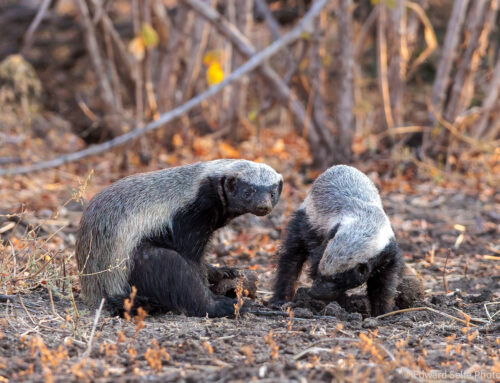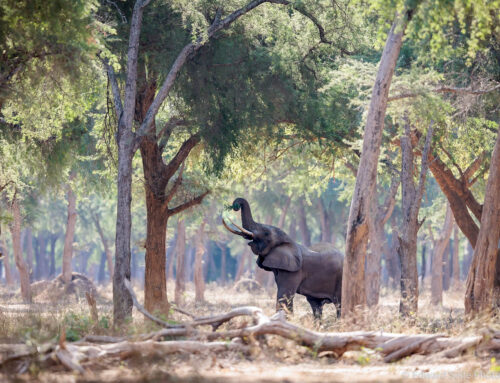Over the last 2 weeks, I have been guiding the longest single trip that I’ve ever put together in South Luangwa. During 17 days, we stayed at 4 lodges in some of the Luangwa’s best wildlife areas. From Kafunta River Lodge, Lion Camp, Tena Tena and Nsefu Camp we saw numerous elephant river crossings, wild dogs, 4 lion kills, leopards too numerous to count, eagles, stately antelope, lion cubs, leopard cubs, carmine bee-eaters, huge herds of buffalo and buckets of stunning light and scenery.
I was joined by John Myers from UK and Kent & Ellen Wilson from Canada. All had lots of wildlife safari experience before and were hoping for some wonderful experiences in South Luangwa. Increasingly, my guests are coming for extended stays, knowing that time in the best areas will surely deliver the results, and preventing the feeling that you have to move on from a sighting to find “something else”. Choosing to stay in these wonderful, long established camps also ensures that the overall safari experience is first-class, with stunning accommodation and the ability to tailor our safari to the needs of the guests. I would like to thank Kafunta Safaris, Lion Camp and Robin Pope Safaris who were all outstanding and provided us everything we could have hoped for – thank you to them, and to all the other camps in South Luangwa that I work with.
16 nights is far too long to provide a minute-by-minute report, so the following summarises the highlights of the trip. I would prefer to include more, rather than less, as I believe that what makes Luangwa special is that there are really very few “down times” when there is not much to see. It happens occasionally, but more often, the flow rate of sightings in quite extraordinary. So when reading through this report, keep in mind that these evens happened over two weeks and represent something quite special on almost every single outing.
John was revisiting stills photography after many years of making excellent films. Therefore, in the early part of the safari at Kafunta, I was assisting and advising so took very few photos of my own. However, in between the excitement of the sightings, I took some photos as the days went by. I was really pleased how quickly John was able to employ my suggested camera set-up and start taking excellent images.
Our first afternoon at Kafunta took us across their pontoon and directly into the heart of the action. The Mfuwe Pride, including Ginger & Garlic the famous lions, were resting on the floodplain just across the water. Unusually, they were sitting up in the late afternoon, and appeared hungry! The lionesses started to hunt, surrounding a puku, but the antelope picked up their scent and ran for safety. What a way to start the safari!
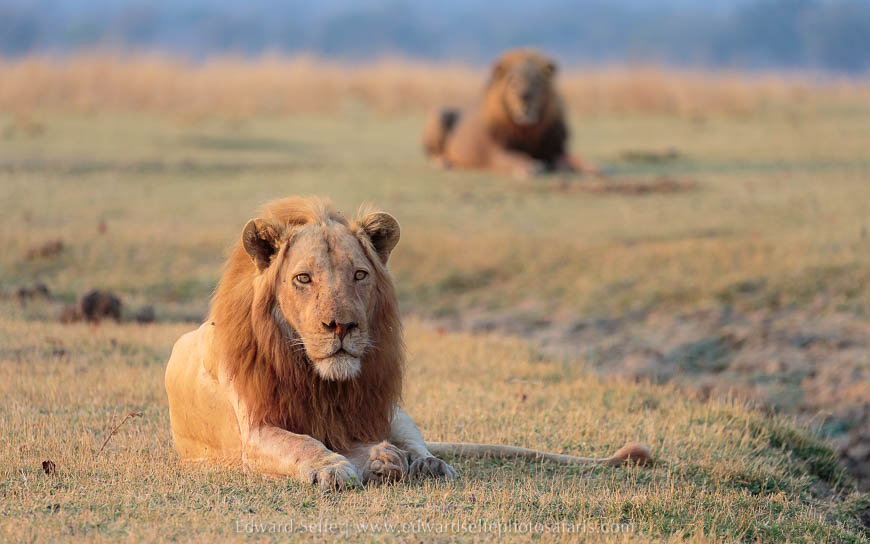
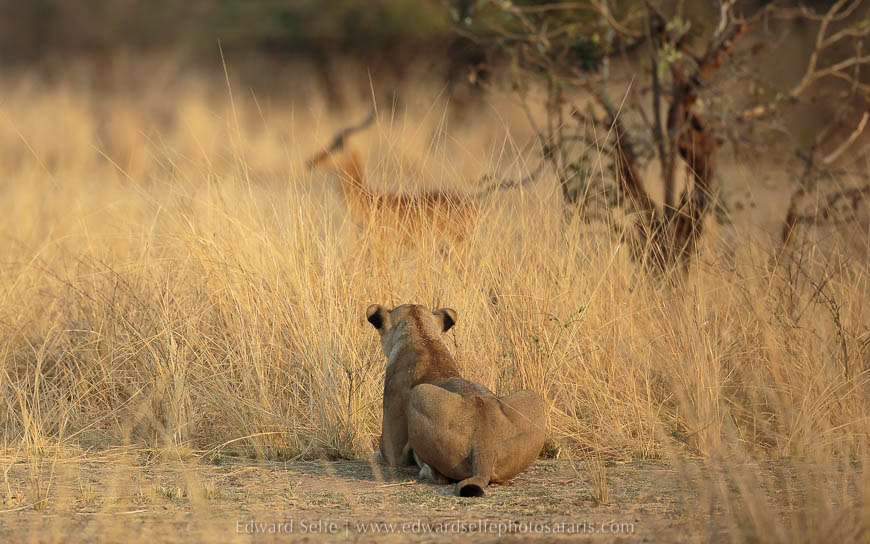
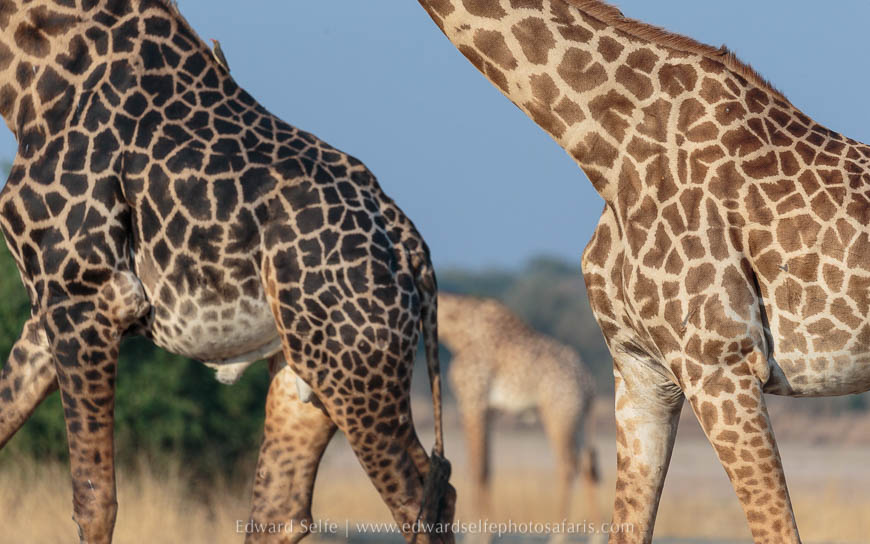
We left the pride to photograph some giraffes nearby, planning to return after sunset and see if they were hunting again. Indeed they were, and after shooting some images with sidelight from another vehicle’s spotlight, we turned off all the lights and waited. I felt, rather than saw, a lioness rush past our vehicle and head into the bushes along the river bank. Guessing that one of the females had caught something we drove quickly to investigate and found the whole pride fighting over a puku that they had pinned in some thick bushes!! Had we just experienced a lion kill on our first afternoon in the park!?
It was tricky to get photos since the bush was thick, so we put our cameras down and tried to film the experience, including the sounds of males grumbling about sharing the carcass with the 6 females and 3 youngsters! Heading back to camp, I was very pleased to have started off in such a way – I knew that we were in for a great couple of weeks in the bush!
During the following couple of days, we worked on techniques and I assisted with advice and ideas, continually re-positioning the vehicle to get the best angles. We enjoyed time with impalas, carmine bee-eaters, a leopard and her cub and giraffes along the river bank.
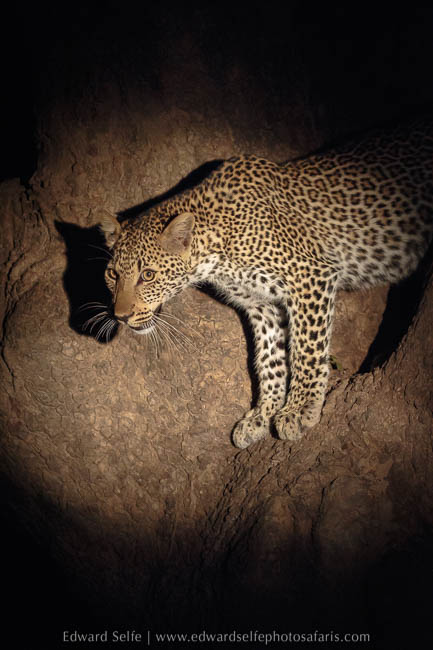
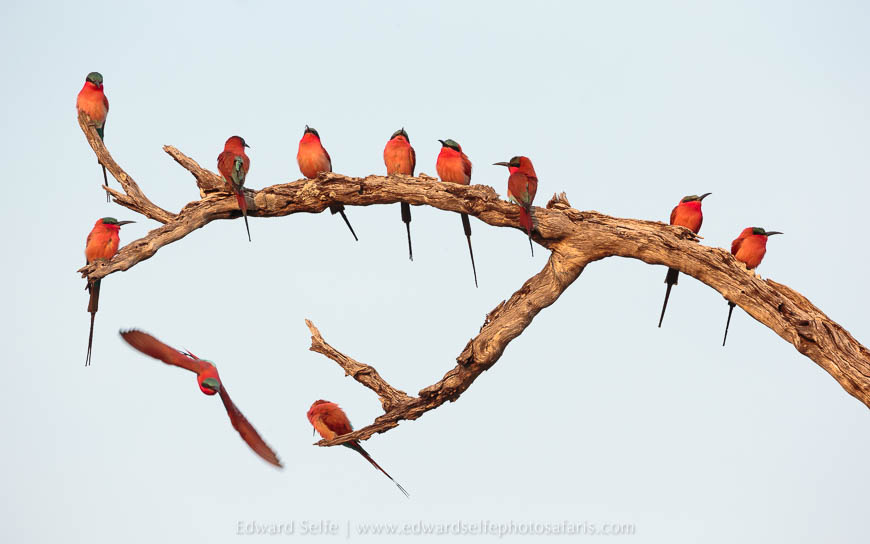
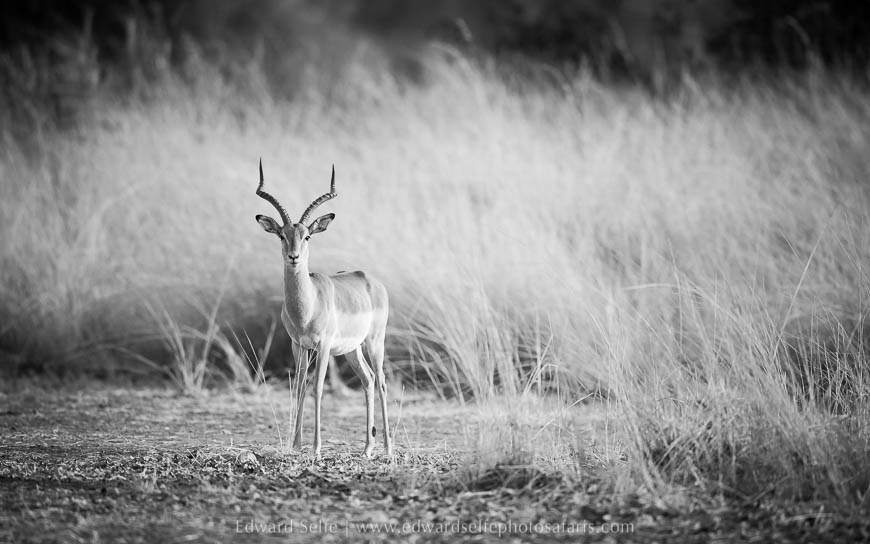
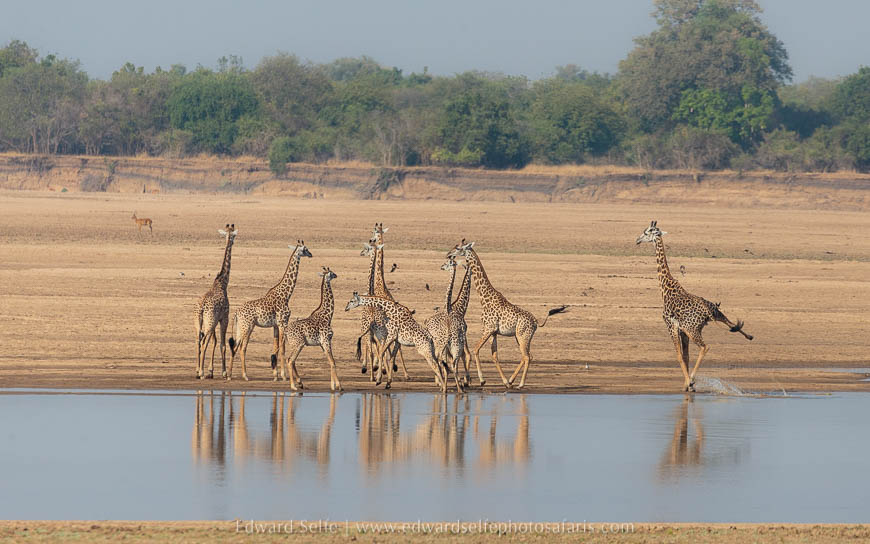
Exploring further south on the third day, we found an off-shoot of the Mfuwe pride who have 5 little cubs! Over the next couple of days, we spent a lot of time with this pride, though the habitat they had chosen to hide the cubs was – understandably – thick and quite hard to see into. However, towards the end of the day on two occasions, the cubs became bolder and emerged from their hiding places and gave us outstanding viewing. This is the considerable benefit of having a long safari; we were able to allocate two drives to locating, watching and photographing these cubs without being concerned that we’d miss out on something else.
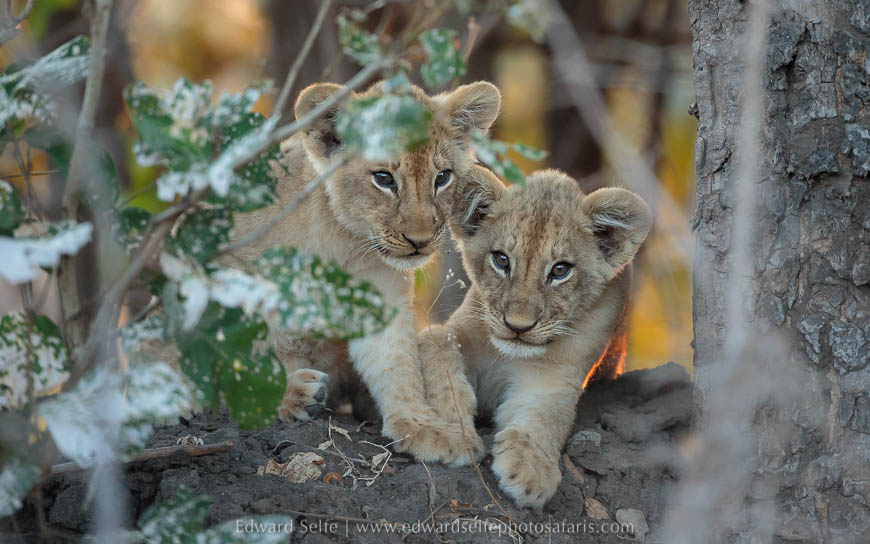
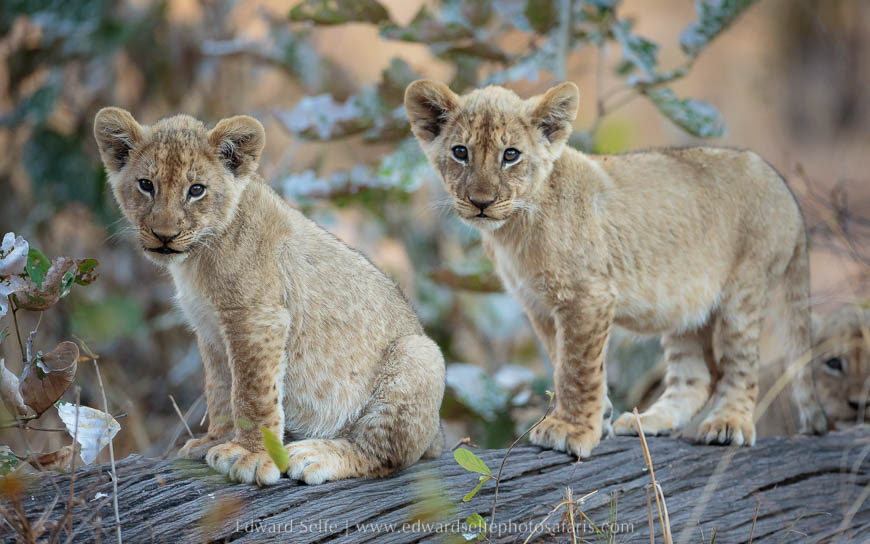
The presence of two lion prides appeared to be keeping the leopard sightings on the quieter side. So rather than go in search of leopards that might be hard to find, we focused on making the best of the lions that were close to camp, and which we heard every night and morning while having dinner and breakfast on Kafunta’s amazing deck.
Early the following morning we went in search of Ginger & Garlic and the females and found them feeding on a giraffe that they had killed under a thick mahogany tree. This had kept the vultures away and concealed its location for 24 hours. The males were pretty lethargic, having eaten their fill, but two females and a couple of the cubs were actively working on the remains of the large bull giraffe. It’s known that giraffe are a target for lions, but it’s not been very common in Luangwa until quite recently. Certainly the contrast of the lions’ teeth against the giraffe’s patterned skin makes for interesting photos.
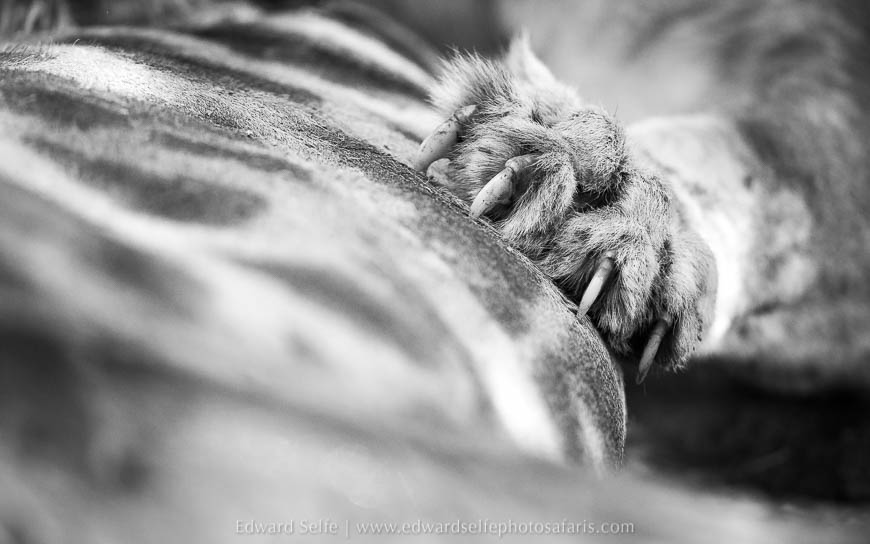
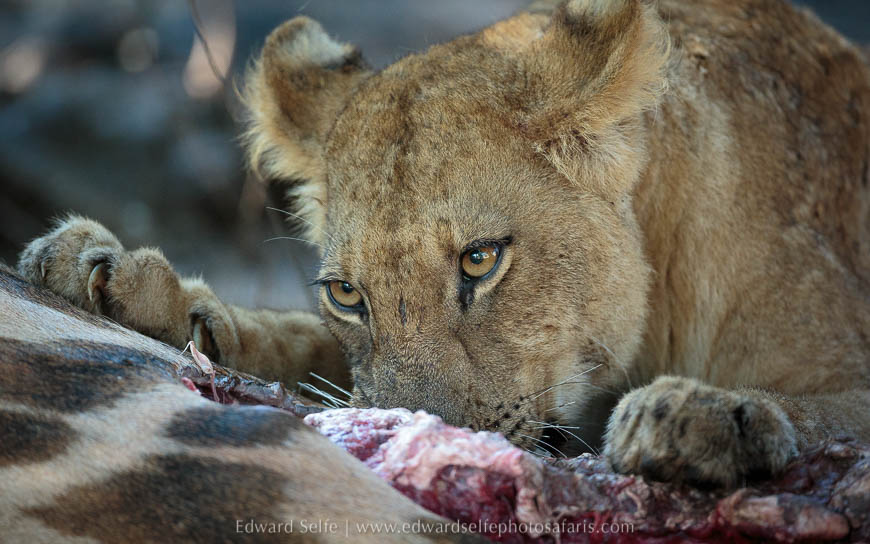
Our final afternoon at Kafunta was spend enjoying a superb elephant river crossing. The herds began to mass on the bank, waiting to cross. We sat for some time, hoping that they might cross at right angles to us, rather than walking away from us, and were rewarded with one better. They entered the water and then played, bathed, splashed and lay down in the cool water! After taking photos, we simply watched as elephants had fun…..there was no other way to describe it!
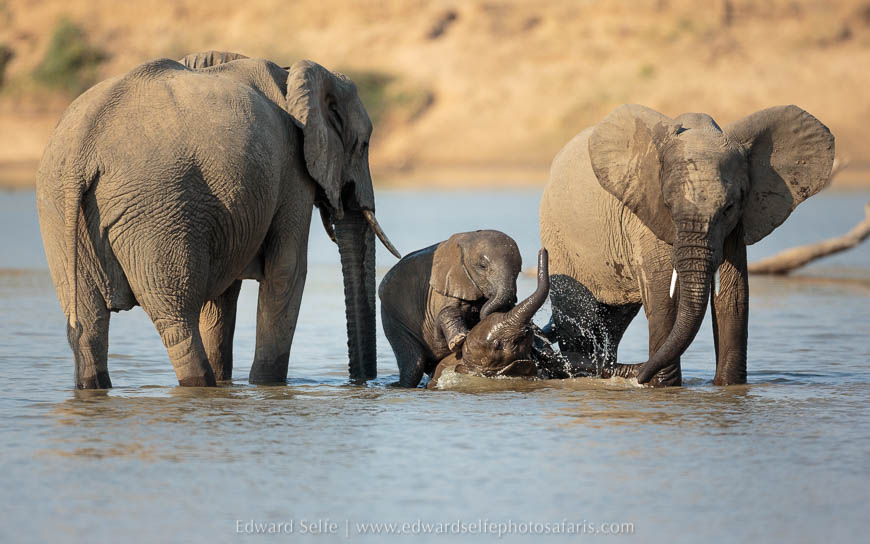
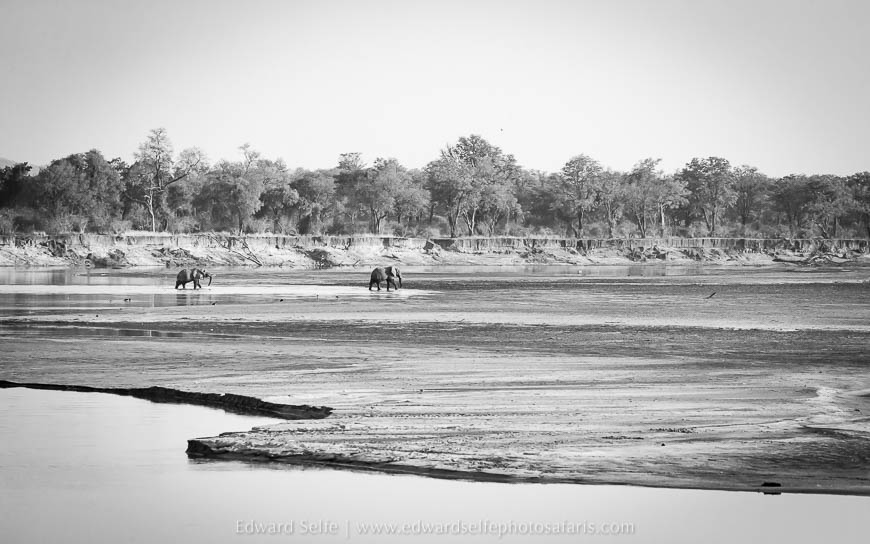
I was excited to head to Lion Camp the following morning as it’s one of my favourite camps in the Luangwa. With its new refurbishment, the experience is better than ever, and of course the sightings are just as good as always. We arrived to an ever-changing panorama of game coming to drink at the camp’s waterhole in front of the decks, a view that kept us mesmerised throughout the 4 days we were there.
There are always a lot of lions at Lion Camp (as you would expect!) but it was actually a huge male leopard who gave us our best sighting of the first afternoon. After honing our skills on some kudu, buffalo and guinea-fowl, we found him finishing off an impala carcass that he had killed perhaps 36 hours before. As the light was failing, we augmented the natural light with a soft spotlight and enjoyed the feeling of being in the presence of Tyson, the largest leopard in the area.
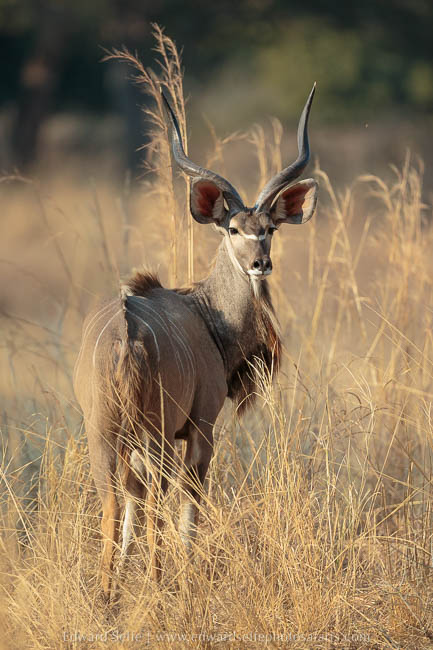
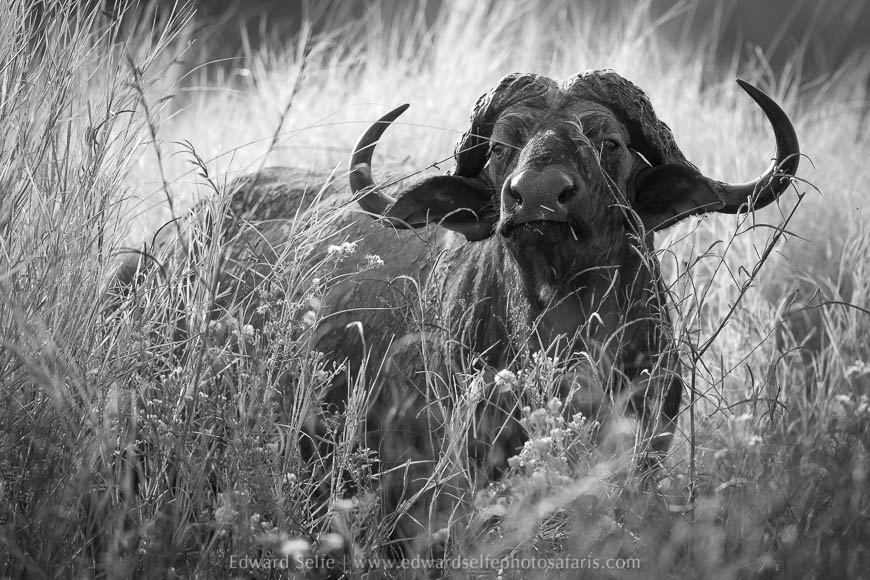
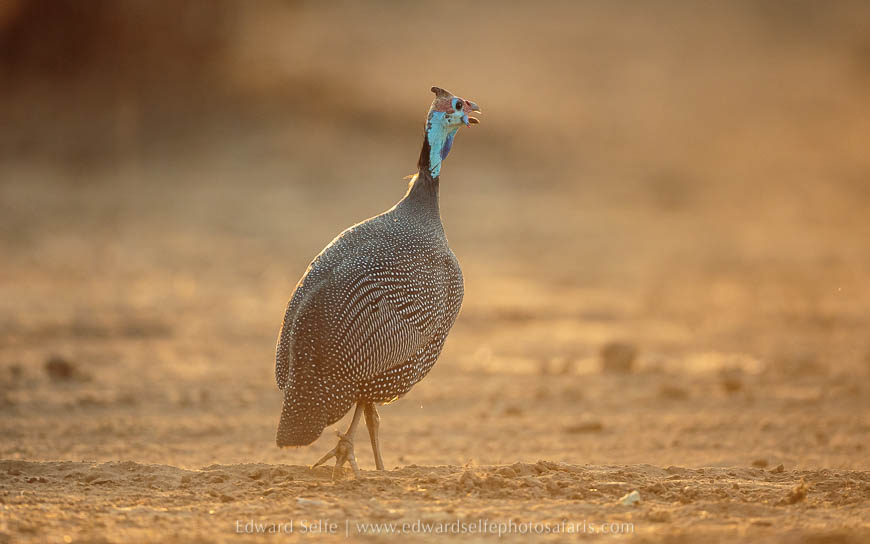
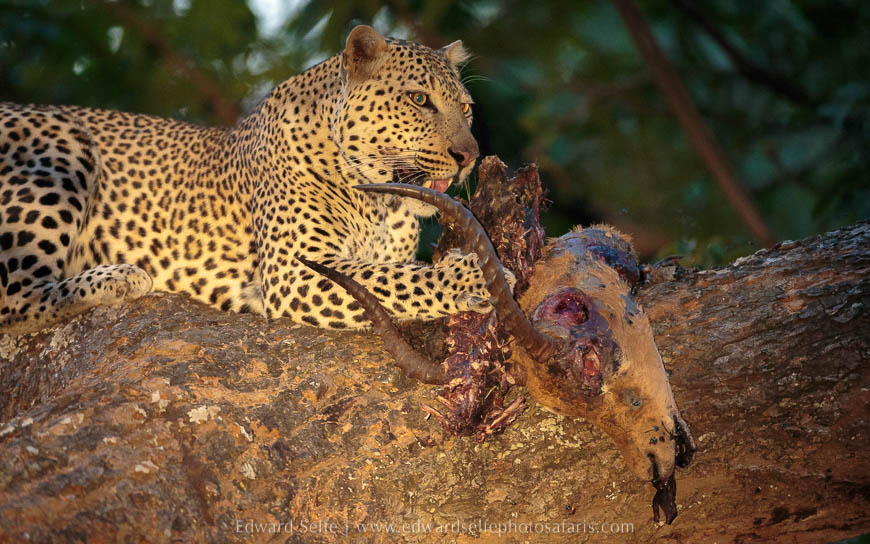
We spent over an hour with him and when another vehicle arrived, we used their spotlight to sidelight him on a branch. We were all lined up, and we only needed him to lift his head for a second to complete the shot….he didn’t! Such is wildlife photography! But when he had woken up, he descended and lay on the ground at the base of the tree (which is more comfortable with a full belly!) and we could create a similar effect there.
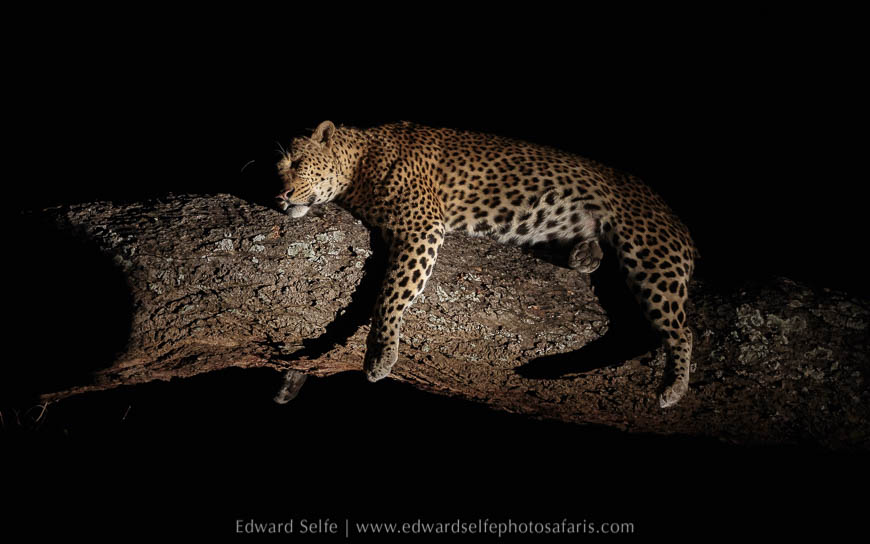
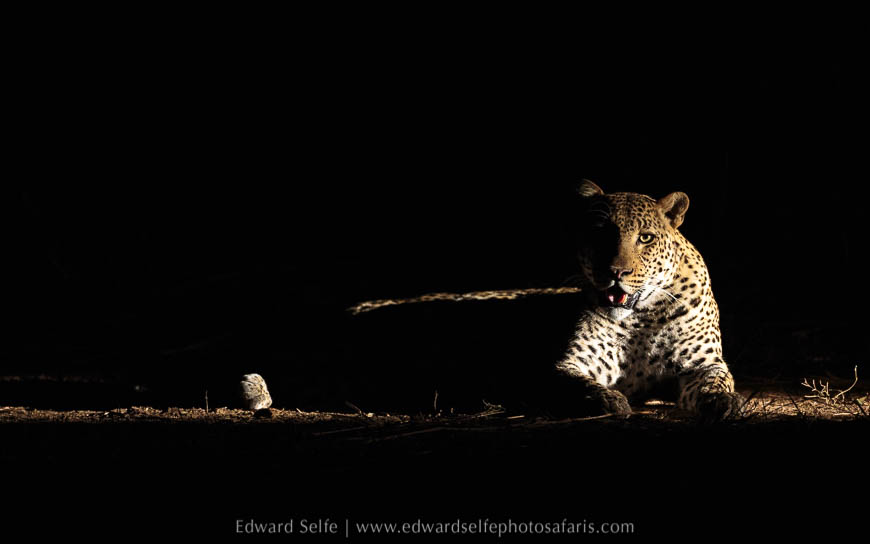
Heading out early – Lion Camp always offer a very light breakfast which enables an early departure from camp – we followed up on a group of young male lions which we had heard calling in the night. They were hunting buffalo which was amazing to watch! They were in the distance and we couldn’t get close to them, but we waited hoping that the chase might bring them closer. Sadly one of the males rushed in too early and scattered the herd, spoiling their chances! We settled for using the magical early morning light to photograph zebras among the beautiful leadwood forests along the margin of Lion Plain.
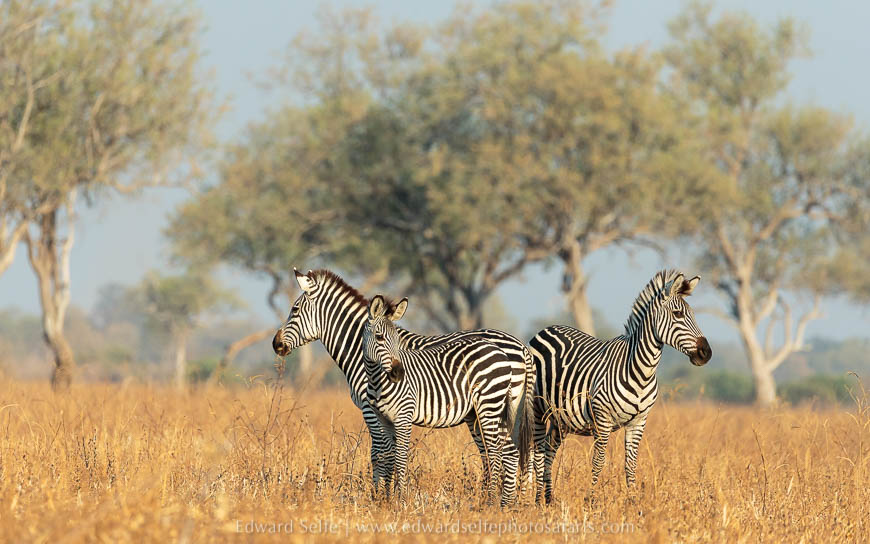
After the excitement of the lions chasing the buffalo, we had a quiet morning. I was just heading back to camp when I heard impalas snorting a warning call in the distance. I took the shortest road to get there, hoping that we might locate a leopard retuning to its tree after getting water. But on arrival, the impalas were looking all directions and didn’t seem to be locked on to a particular threat. We looked around and very quickly located an enormous python that had caught and then wrapped its coils around a young impala!! This is something that is extremely unusual to see. Sadly, however, the vibrations of the vehicle frightened the snake and it released its grip on the impala and slipped off into the bushes. When feeding they are extremely vulnerable so they prefer to leave a kill than risk injury. I regret influencing the outcome in a natural event but it was certainly not intentional; the python was hidden in a patch of long grass right next to the road which we could only see into when we were too close. After panting for a while, the antelope got up and ran away with only a cut on its back leg to show where the python had caught it.
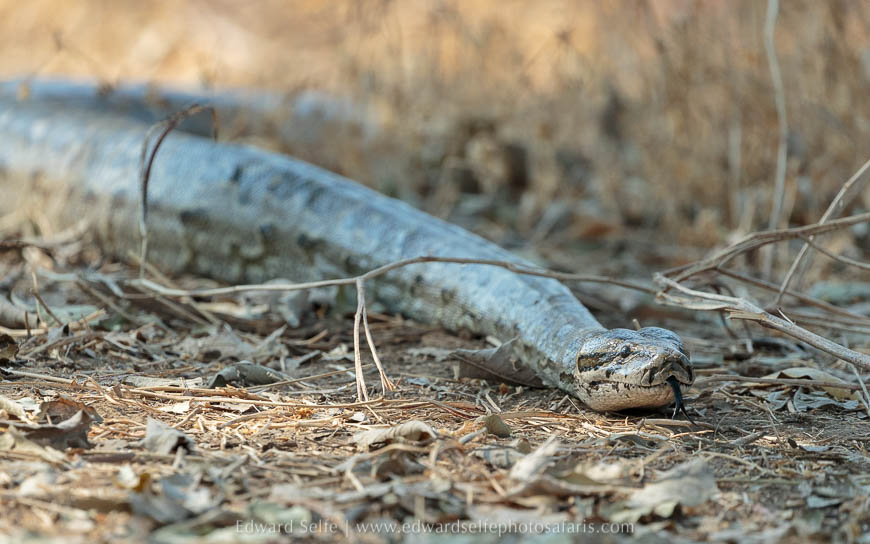
We returned to camp exhilarated by such an unusual event and discussed the finding of a large 4-5m python with the other guides. In the afternoon, some of the camp’s other guests headed out to search for the python and we searched an area where Chipadzuwa – a well-known local leopard – had been seen in the morning.
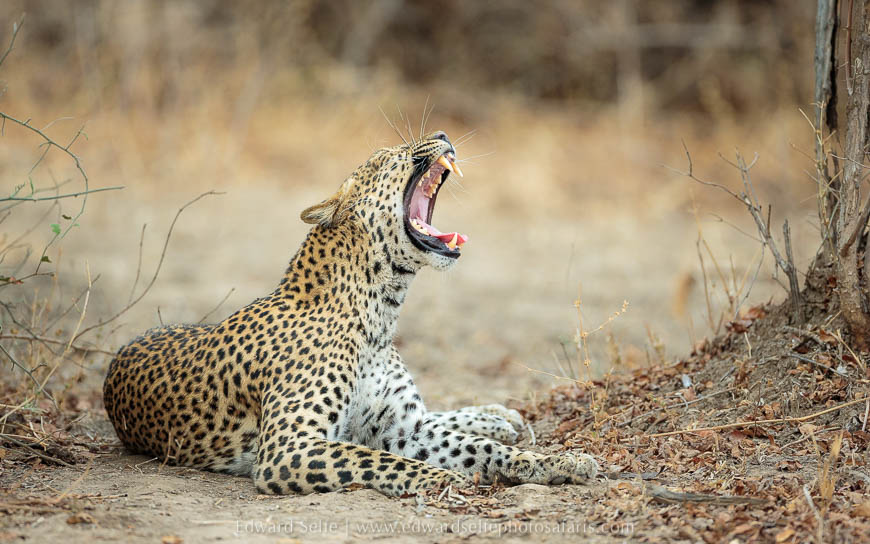
We quickly found her and spent the whole afternoon with her. After initially rousing and moving off, she then lay for a couple of hours on the broken ground and slept. We kept hoping that she would get up and climb a tree, or start to hunt, but she chose to rest instead. It became apparent why this was the case when darkness fell and she began to call repeatedly while walking through her territory. All leopards will call to advertise their presence, but this was far more frequent and had a more urgent tone to it….she was calling for a mate. Repeated calling and the oestrous phase are very tiring which is perhaps why she had been so inactive in the afternoon.
We found her the following morning as well and spent an hour with her as she moved through her territory in Fish Eagle lagoon, again calling continually.
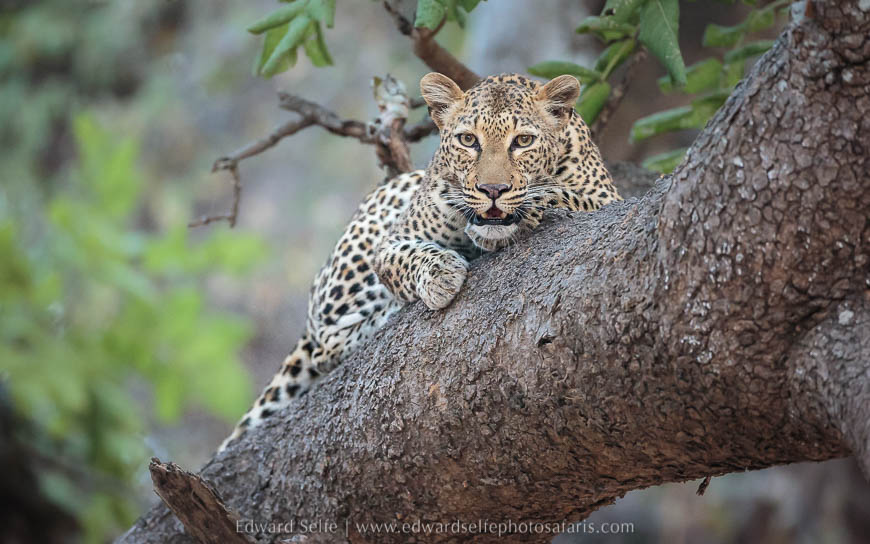
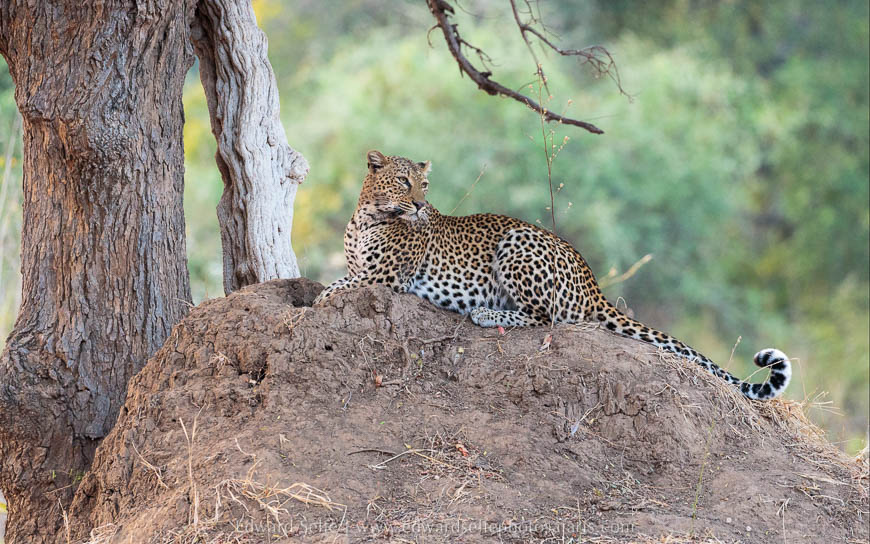
After losing her into a very thick tree, we spent the rest of the morning with beautiful light on guinea-fowl, elephants and a trio of waterbuck that lined up very nicely for us! We didn’t take so many photos that morning since the sightings were a little thin after we left the leopard and her calls. But that is part of the natural cycle of safari and I have learned that when sightings are slow, it’s best to take time and watch the things that you might not normally stop to photograph. Have you ever watched how busy red-billed queleas are when they’re feeding on the ground? Or tracked a little sparrow hawk through the trees using the tell-tale calls of enraged squirrels and little birds? Taking time to stop and absorb the surroundings is as much a part of my safaris as the pursuit of sharp, well-composed images of the headline species.
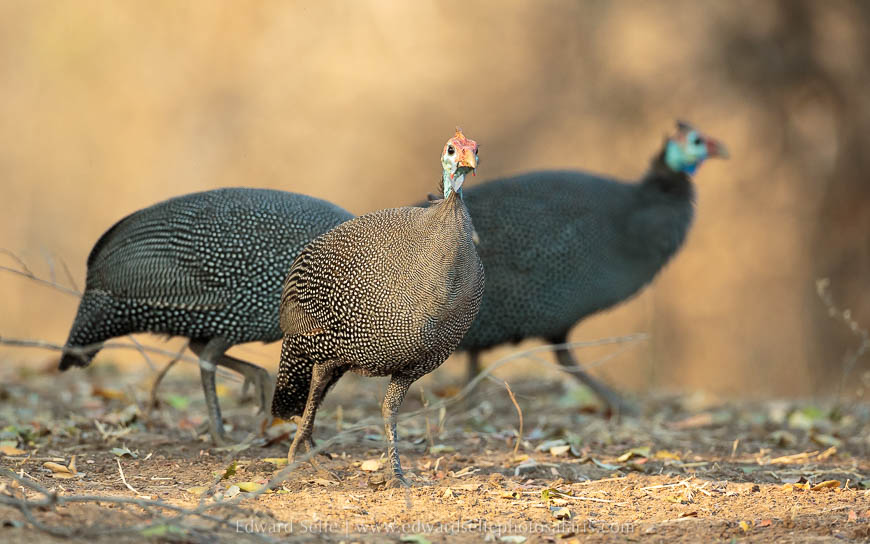
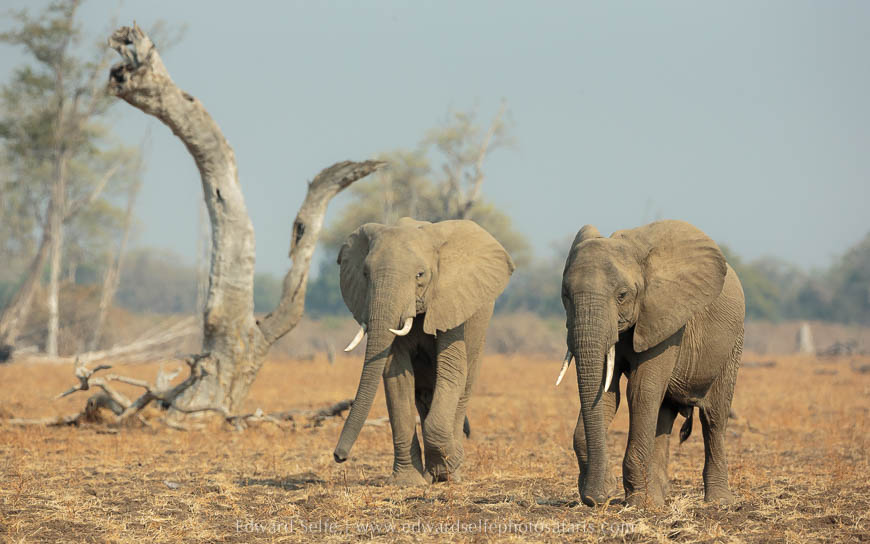
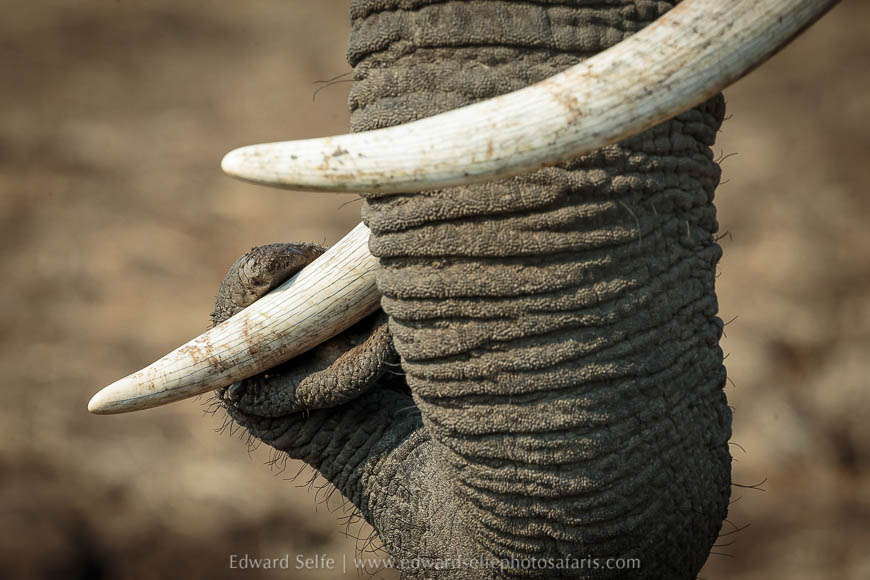
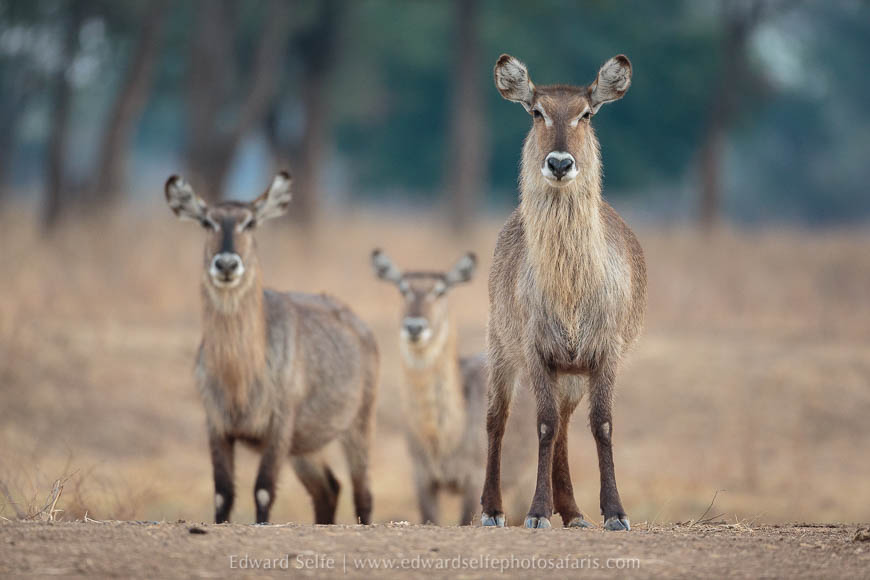
That afternoon gave us our first really wonderful Lion Camp lion sighting. The Hollywood pride – who we’d seen a couple of times in previous days but not in a good location for photos – were resting along the banks of the Luangwa. The light was perfect so we settled in for an afternoon of lion activity. There is something about the lions, the light and the surroundings at Lion Camp that gives images from there a very special effect. I really wanted to fill our cameras with great shots and it turned out that this was exactly what we got!
Initially the lions simply rested in the shade but they soon rose and walked along the bank towards a gully where they could get to the river. We moved in front and captured shots as they approached us across the open ground with warm sunlight on their tawny coats. As the light started to dim, they lifted their heads and started to eye up the puku and impala feeding on the grassland nearby, and I knew that we would have a hunt the moment darkness fell.
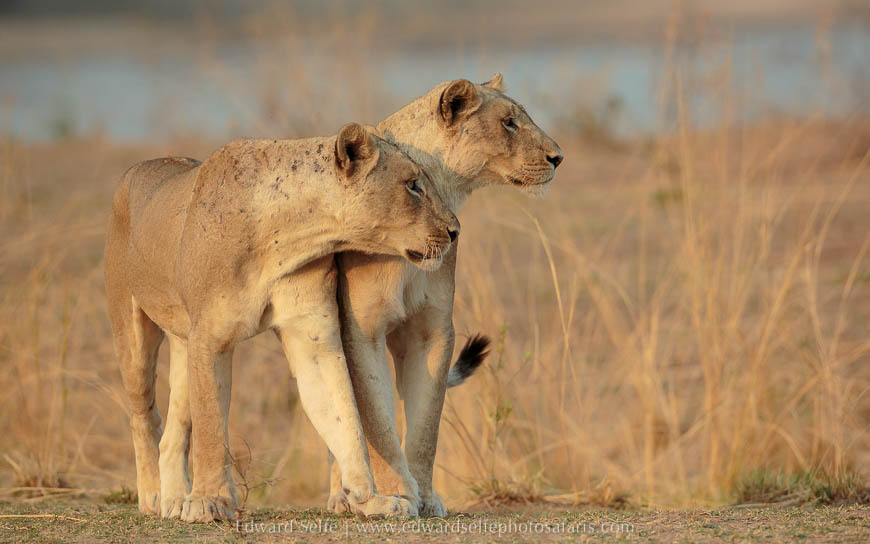
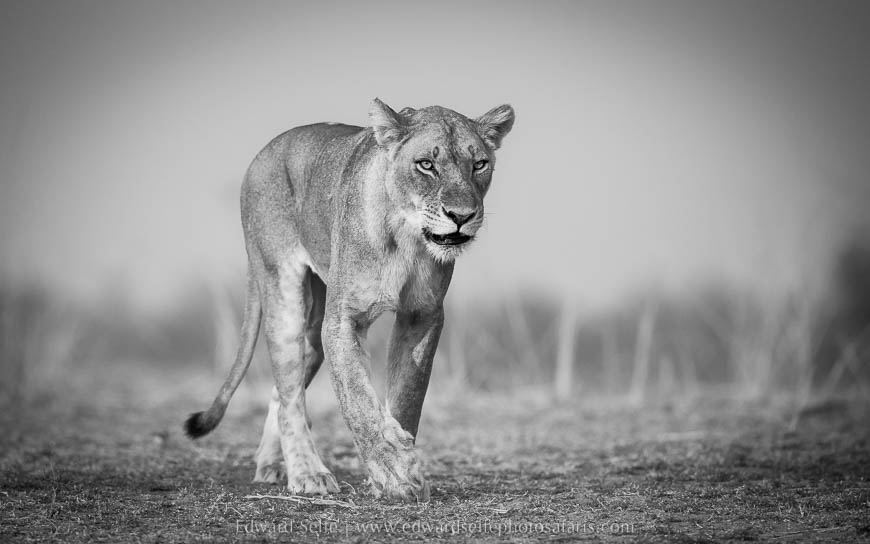
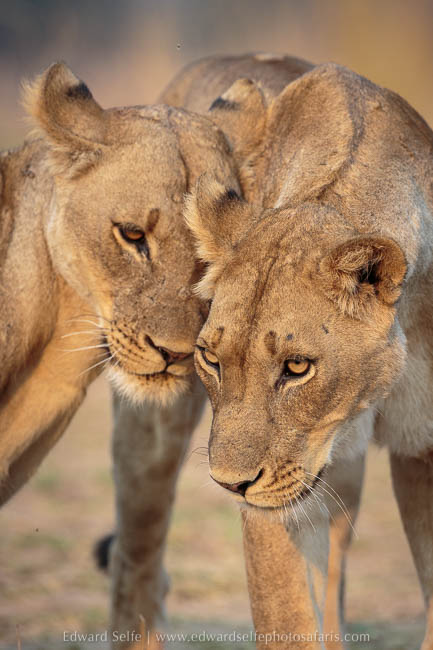
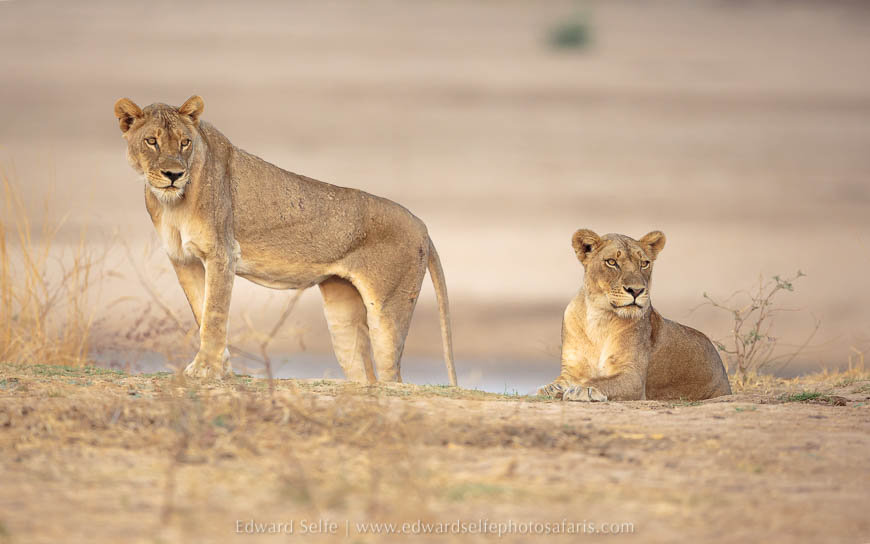
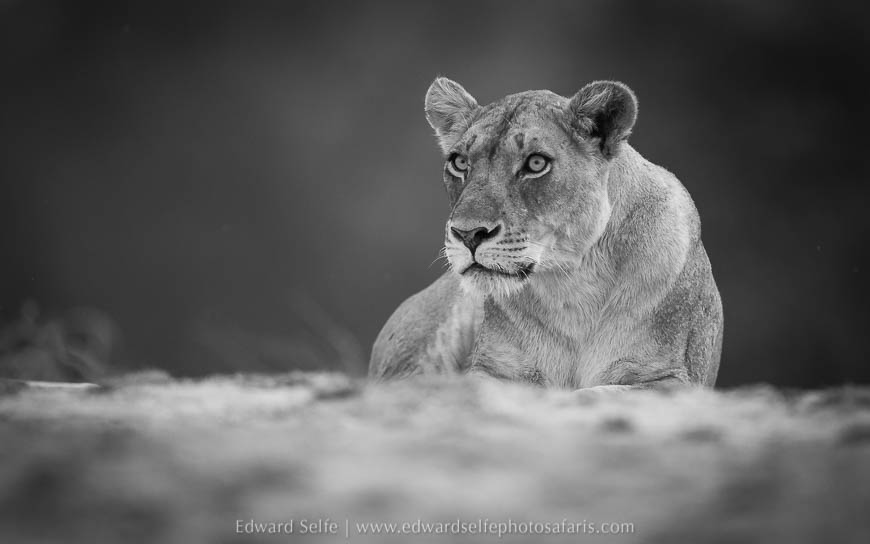
Before it was even fully dark, the pride split with the bulk remaining on the river bank while two lionesses took a wide line around the antelope herd and started to push them back towards the rest of the pride. It was fascinating to watch the unspoken coordination between them. We had all the lights turned off, but we could hear the antelope starting to get twitchy. As the first lionness charged, we waited and then turned on a red spotlight so that we could just make out the lions and antelope running in a melee across the plain. We waited again until we heard the unmistakable sound of lionesses grunting and grumbling and we knew that they had caught an antelope! We arrived as the first 3 lions were starting to feed and the remaining 3 joined moments later. With a small carcass to share, the competition between them was intense and photos were almost impossible. We took some videos instead!
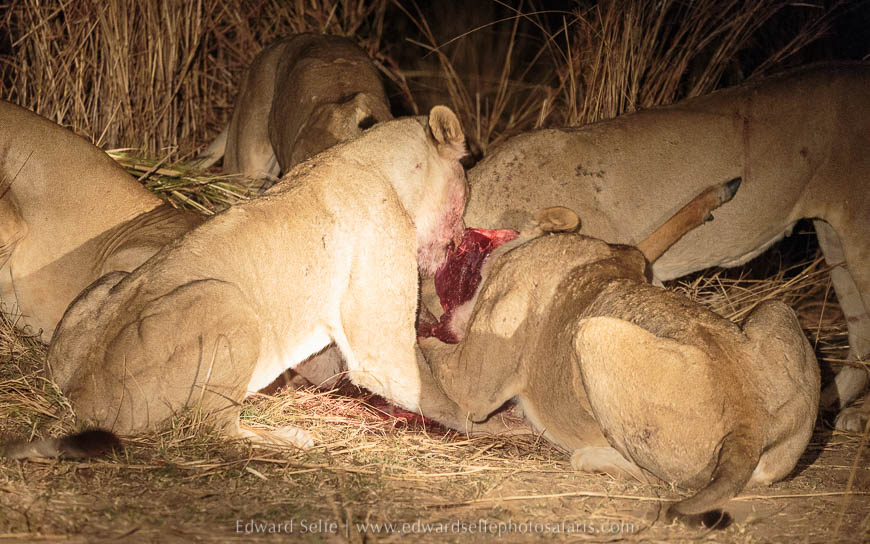
Without warning, 3 hyaenas came bursting onto the scene with an enormous noise and surprised the lions momentarily, forcing them off the kill. It was a bold move since the lions might have retaliated, but it was just enough for the hyaenas to snatch most of the carcass and rush into the bush. There followed 20 minutes of total mayhem, as lions and hyaenas ran in all directions trying to secure the scraps of what remained of the kill. After taking some photos, we simply sat in the dark, listening to the amazing sounds of competing predators all round us. Things started to settle eventually and we found one lion cowering under a bush trying to finish off the scraps of what she had managed to secure. Among two weeks of truly memorable events, this was really something that will stay with me; the noise, the dust, the audacity of the scavengers and the fact that we had seen the whole event from start to end.
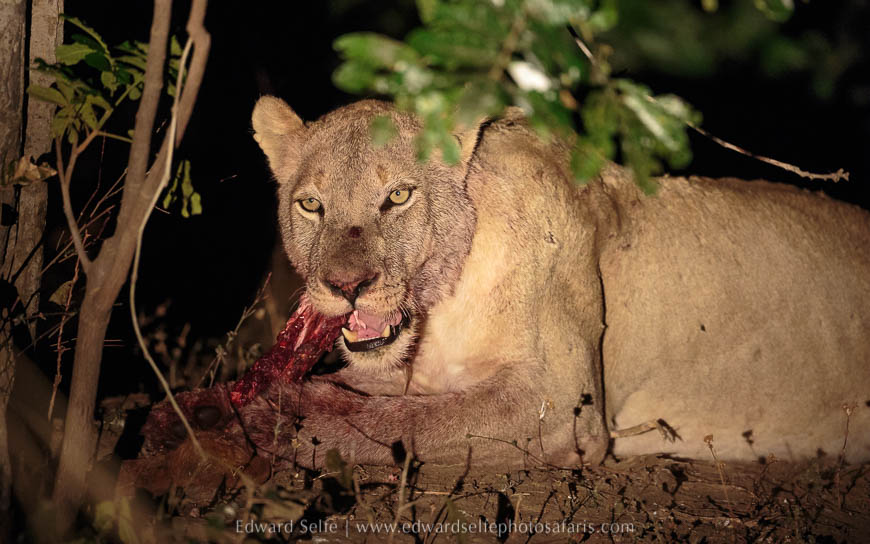
Our last morning at Lion Camp took us to a carmine bee-eater colony where we worked on a variety of techniques including prefocusing and waiting for the birds to lift off from the river bank. This is a particularly beautiful section of bank so this technique worked well.
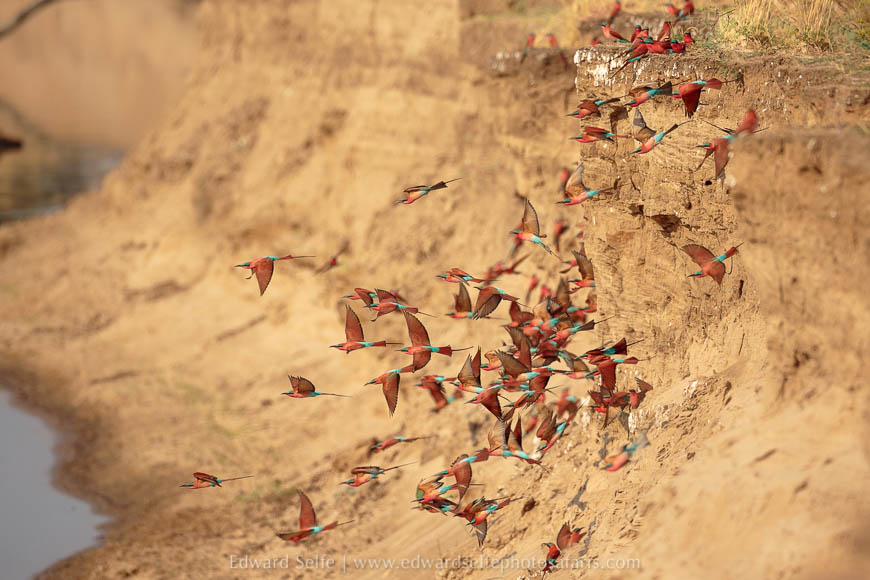
After spending some time in the massive ebony grove south of Lion Camp, we went for tea-break opposite a favourite elephant river crossing and drinking point. We were disappointed to find no elephants there, but we waited while we had coffee and were rewarded with the arrival of more than 65 elephants all at the same time. As they started to emerge through the bushes, it was apparent that this was going to be something special. I outlined how to take a series of images that can successfully be stitched together in Lightroom and we then sat and watched as herd after herd descended the bank on the far side (the Nsefu Sector) and arrived at the water’s edge.
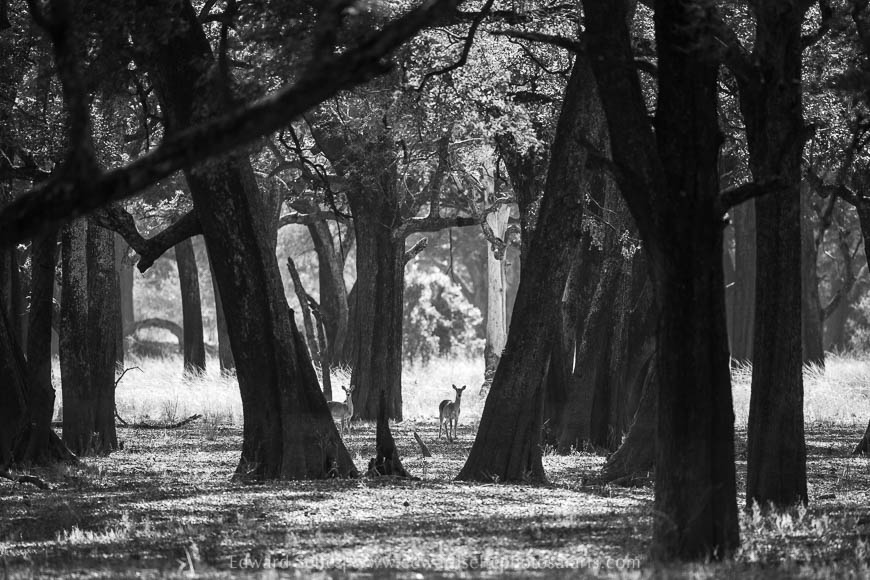
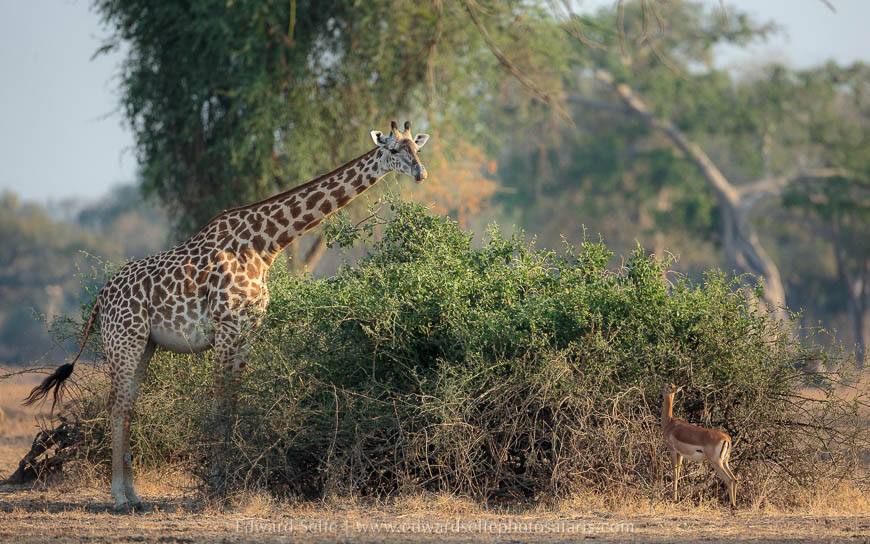

To see these huge mammals in large numbers, so vast in their own right, but dwarfed by their surroundings was beautiful and humbling. I take great pleasure in knowing that there are still vast places that support the quantity of vegetation required to sustain mega-mammals such as these in healthy populations. Long may that continue.
After a morning drive where we found both parts of the Mwamba-Kaingo pride near a large ebony grove, and briefly tracked a leopard through the thickets, it was exciting to cross the river from Lion Camp into the magical Nsefu Sector. Home to just a handful of camps, this is certainly the finest wildlife area in the Luangwa and one that features on very many of my trips. We checked into Robin Pope Safaris’ beautiful Tena Tena, a camp that is nestled among large shady mahoganies with a stunning view of the river. We would be here for 3 nights and I was excited by the prospects ahead.
After settling in, we headed out on safari for the first afternoon drive. The light was poor so we spent lots of time on a few sightings, working on compositions. We also talked more about panoramas and how to lock the focus and the exposure and then take a series of photos that can be stitched together later. This can be helpful if you want to make a large canvas, or if your lens is too long to fit a particular scene into the frame.
The camp staff were great and arranged an early breakfast for us so that we could begin our morning safari long before sunrise. We enjoyed a female giraffe sitting under a tamarind tree, a beautiful juxtaposition of textures, and then headed to the elephant crossing point to wait on the many herds that would surely come. My guests got wonderful shots of two herds crossing against the stunning backdrop. I had been many times to that crossing so set my self the target of only using my longest focal length and only using it in portrait orientation! Sometimes, setting small challenges like this forces new ingenuity into your composition!
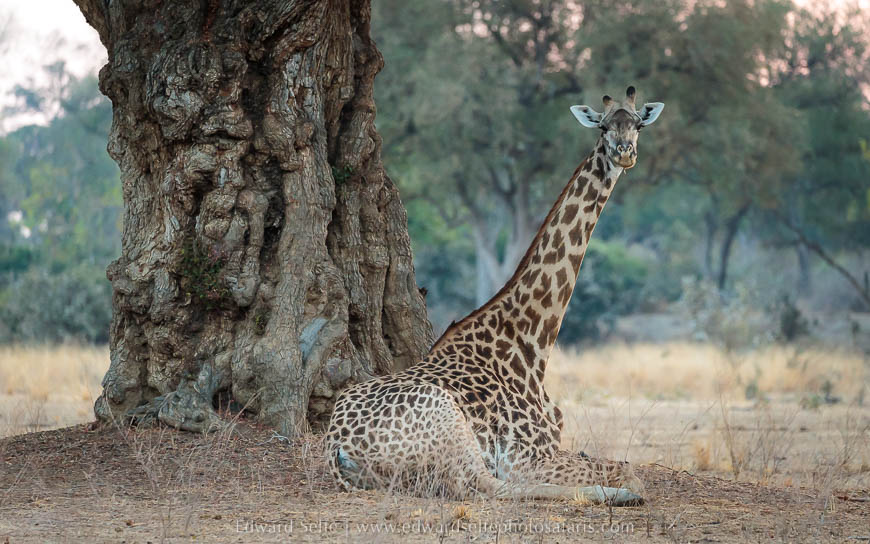
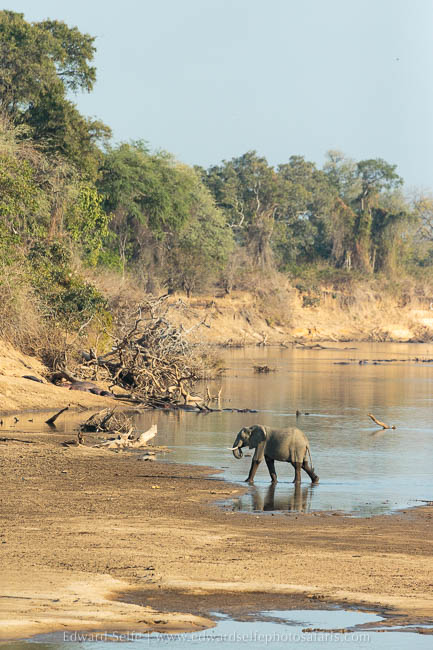
We ended up in one of the Nsefu Sector’s 4 ebony groves where we watched as a group of baby baboons ran rings round the adults taking care of them.
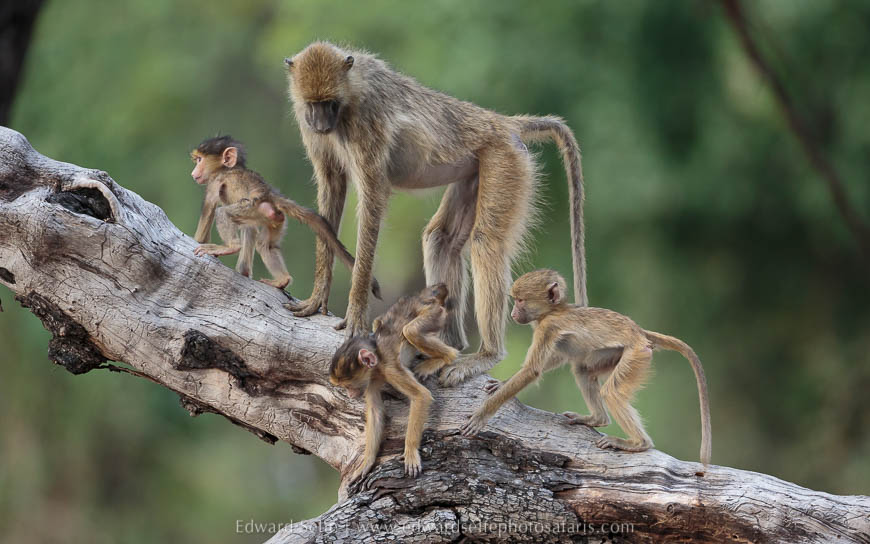
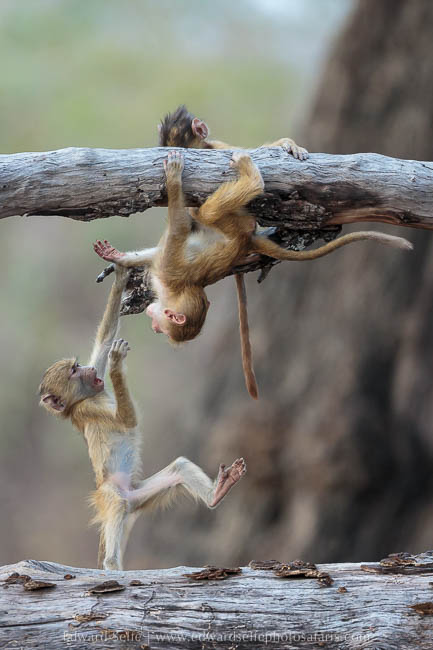
In the afternoon we headed to the Crocodile river to scout for the Nsefu pride. They were full and lethargic but the light broke through at sunset and their location on top of the steep bank gave us the chance to be below them.
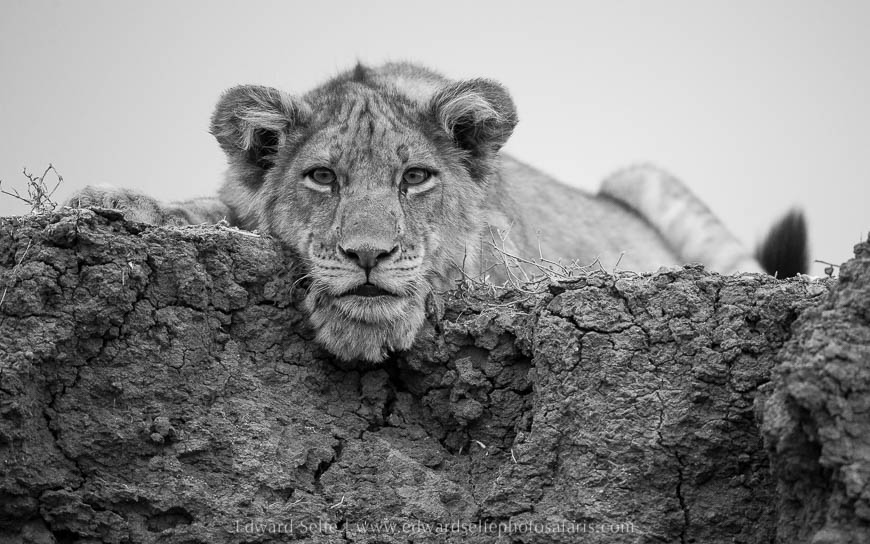
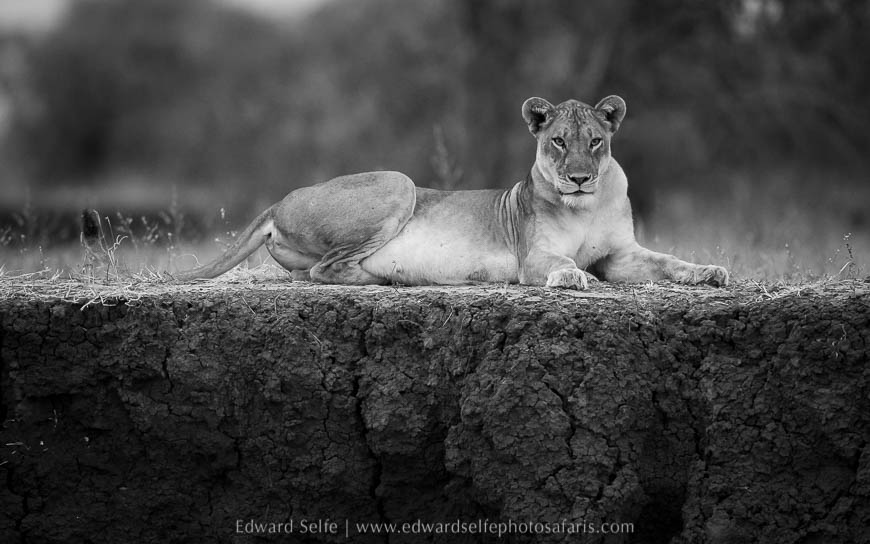
Starting once again at dawn the next day, we found a honey badger that tolerated us long enough to take some great shots of this normally elusive character. With light levels still very low, we were working at the limits of our equipment but with some advice and patience, we all ended with some usable shots. Moving on from this, I wondered what the Nsefu sector would offer us this time. Alongside all the usual encounters that I have become used to in that area, each trip tends to give us at least one really special event. When sightings are slow, I remind myself that “our time will come” and keep going out early, staying out late and reading all the signs of the bush.
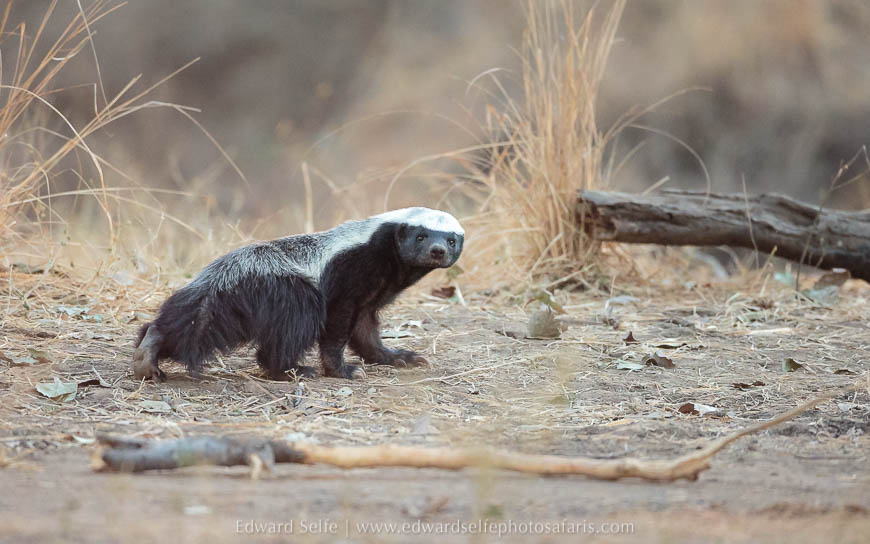
With this in mind, we went in search of suitable subjects for the stunning morning light that was building up after the brief honey badger encounter. Almost immediately, I spotted a chance for a long-range shot of elephants drinking at Lunga Lagoon, and this was quickly followed by wonderful time with a large family of giraffes who are often found between Lunga and mwana Lunga lagoons. They have 4 young calves and there is always interaction between the youngsters and the females. We approached carefully and waited in a spot where the background was good.
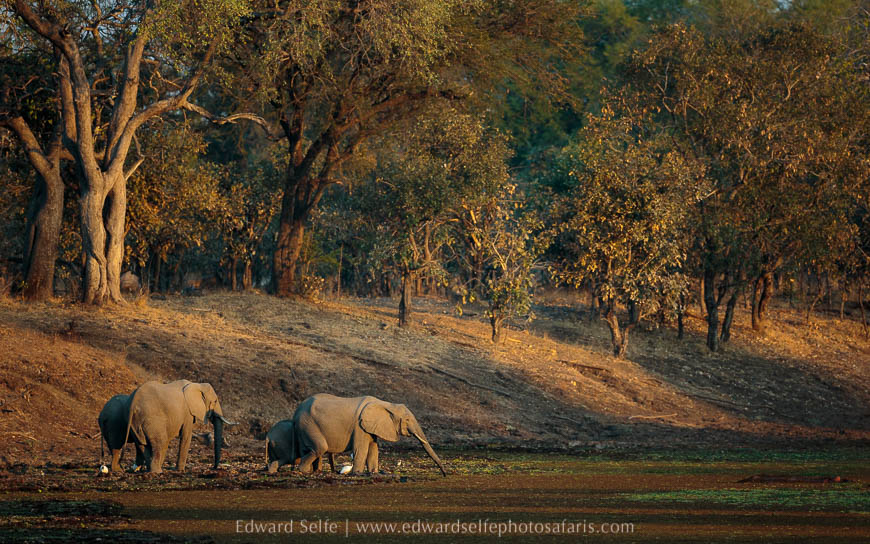
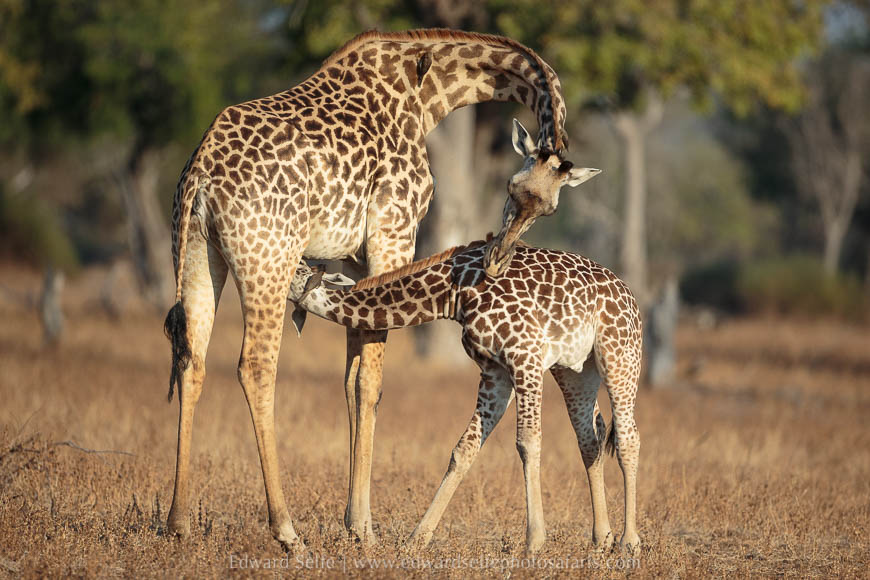
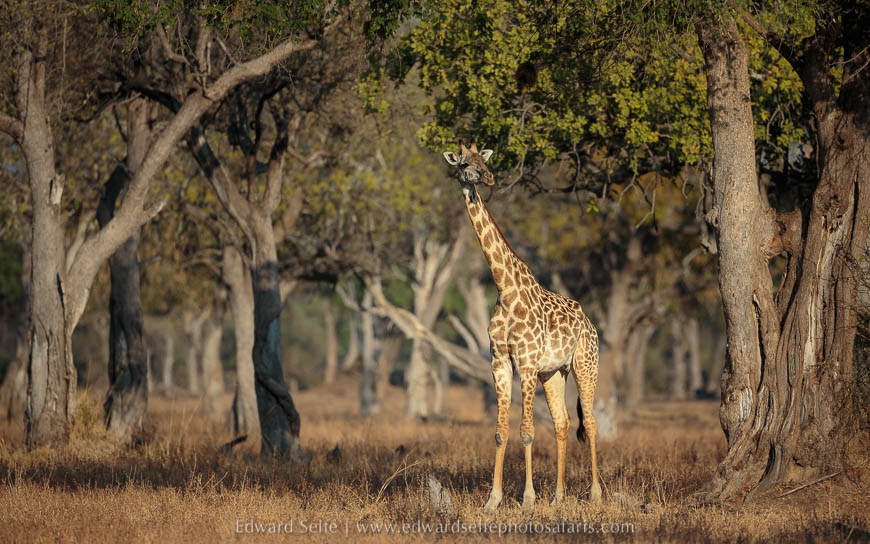
The ground hornbills appeared to be more evident than normal (perhaps they felt that the vehicles were more evident that normal!) and we watched a pair with a young chick as they went about their business that same morning. Given that they are so heavily threatened across much of their range, we are really lucky to be able to observe them in good numbers and to know that they are breeding and succeeding in the Luangwa.
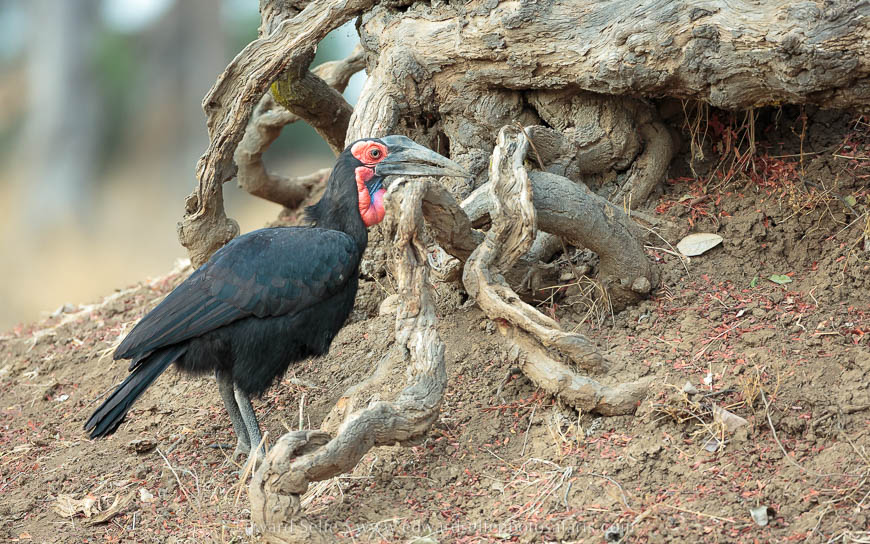
We were very excited by reports from further north that the hot springs pack of wild dogs had been seen between Tena Tena and Nsefu Camp. Dogs are always on the move, and we didn’t know when or if we might see them again so we searched for them that afternoon. It was great to see them, and we enjoyed some interesting interactions, but they spent most of the afternoon light doing simply nothing! While some packs will play, chew sticks and even chase birds, this pack of 9 males and 1 female barely moved until the light was completely gone. Just as the light was failing, the dogs rose and rushed into a bush where they killed a…..dove. Such is life on safari.
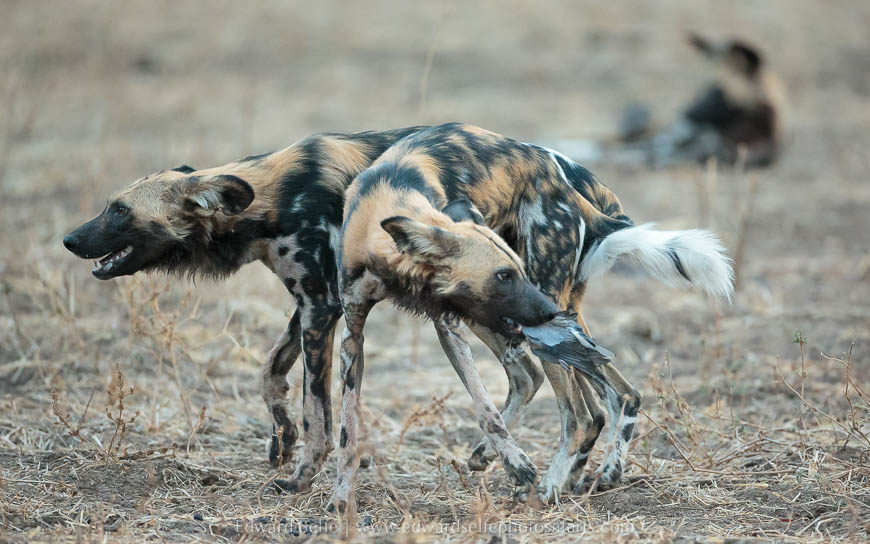
This marked the end of our time at Tena Tena and the beautiful woodlands, lagoons and habitats that surround it. We packed up that night and left early with our luggage for a morning drive to Nsefu the next day. On the way, we took in some nice light on a little family of warthogs and spent a long time with a large herd of buffalo that came to drink at Lunga lagoon. When you know that you have another 4 days in the amazing game-rich environments of Nsefu, there is no need to rush – the sightings will come.
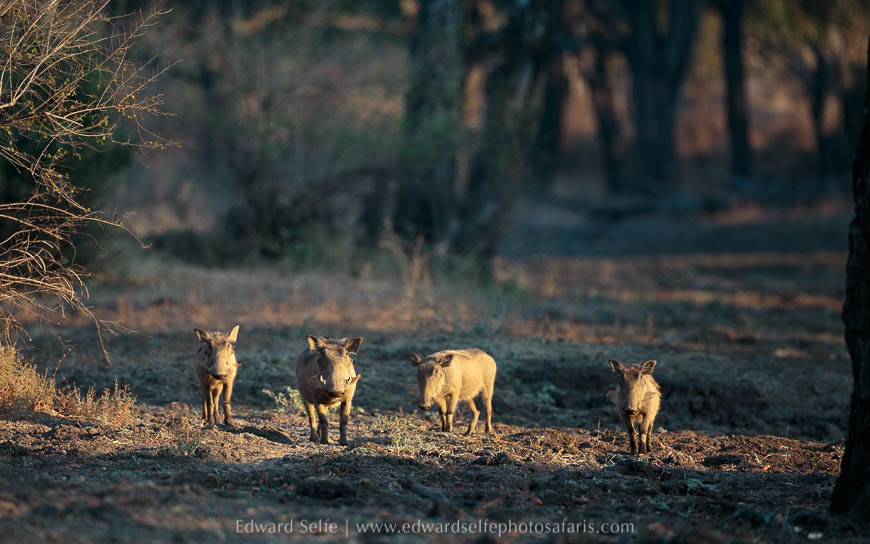
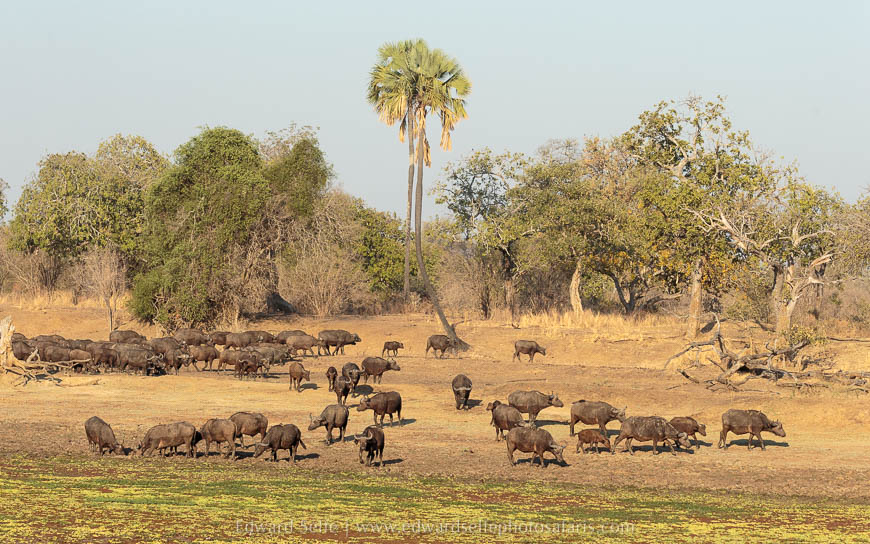
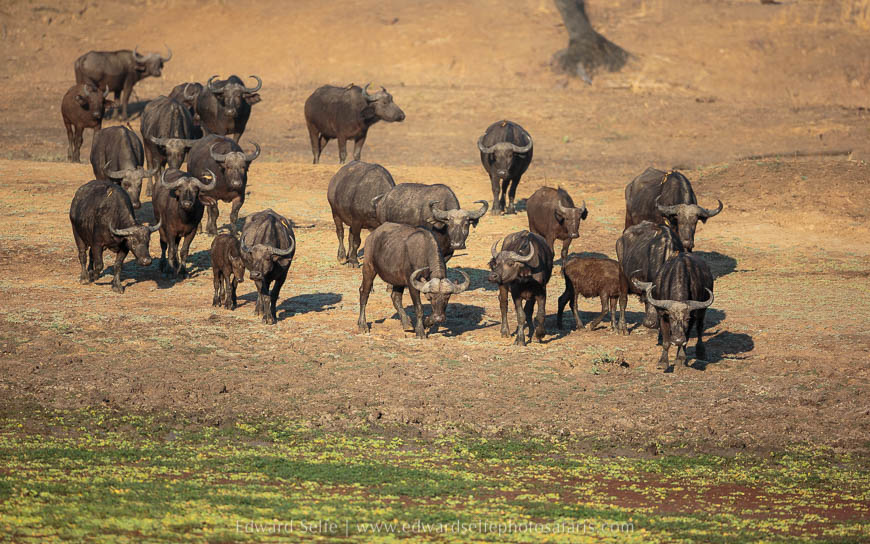
Nsefu Camp was the first tourist camp in the valley, built in the 1950s. Norman Carr certainly knew what he was doing when he chose the site, perched on a magnificent bend in the river with a long view of water in both directions. When we arrived, there was a herd of elephants crossing the river in front of the camp, and there was barely a moment during the 5 days that we were there when this was not the case. There’s a style and comfort about this camp that immediately welcomes vistors, and the whole experience is full of promise; promises of great sightings, incredible encounters and life-long memories. I love Nsefu Camp.
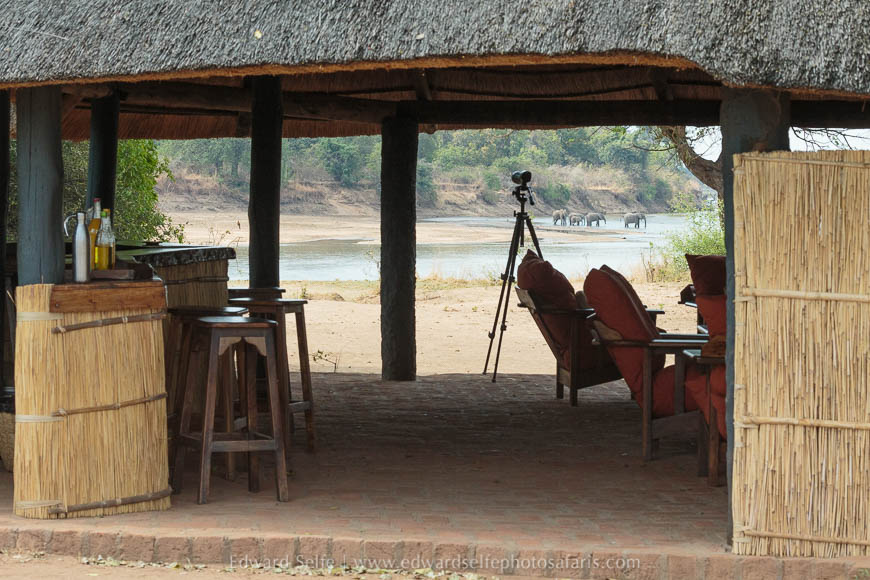
We settled in and prepared for our first afternoon safari. I made no secret of it; on our first afternoon I was going to look for Olimba, the well-known leopard of that area. We had been enjoying great lion sightings in the Nsefu Sector, but leopards had so far eluded us. Well, it didn’t take long. Barely an hour out of camp, we found her emerging from the gully where I have so often watched her hunting, and walking to a fallen tree where she lay in full view. Needless to say, we were thrilled that Nsefu Camp had already delivered the goods! We took traditional side-on shots and then I manoeuvred to get an alternate view from the front. I could see that the light was going to appear below the clouds so I took a chance that it might hit her through the trees… I was right and we all took some spectacular shots. She rarely lies out in the open so this was a particularly special encounter.
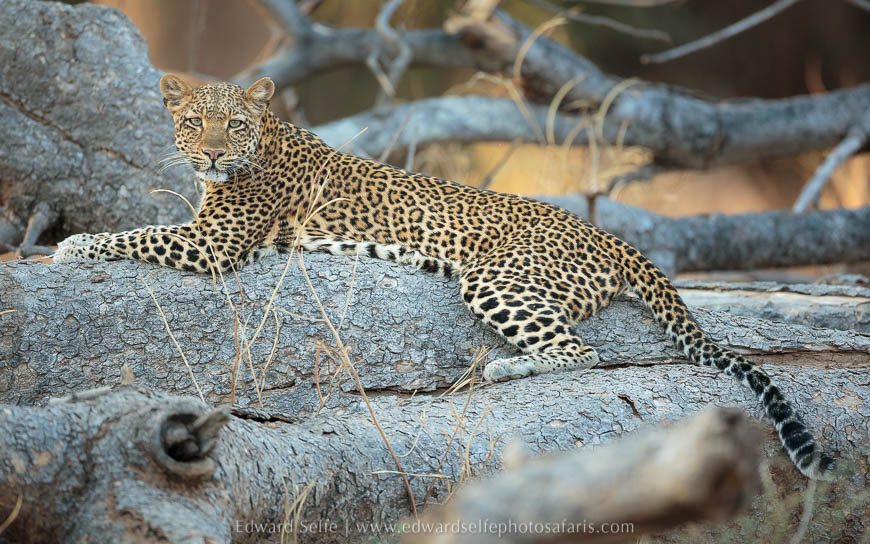
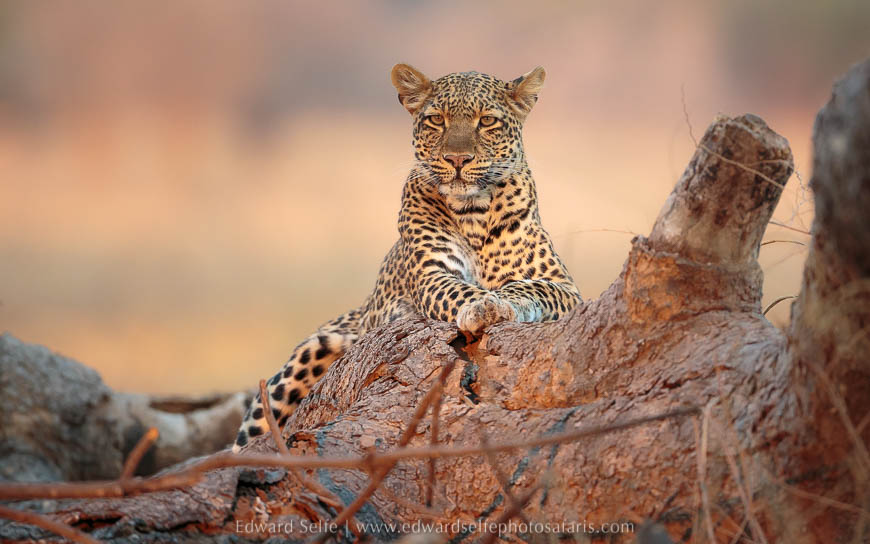
As it grew dark, she began to hunt. She has a 3 month old cub so she needs to feed frequently. Knowing her habits, I drove a long road around a floodplain and met her as she re-emerged from the thickets. Placing the vehicle in a small channel, we got beautiful low-level views. As it became totally dark, we left her to hunt. Following with a spotlight will likely only ruin her chances of hunting, and we enjoyed such great photos during the afternoon that it seemed unnecessary to shine a bright light on her at night.
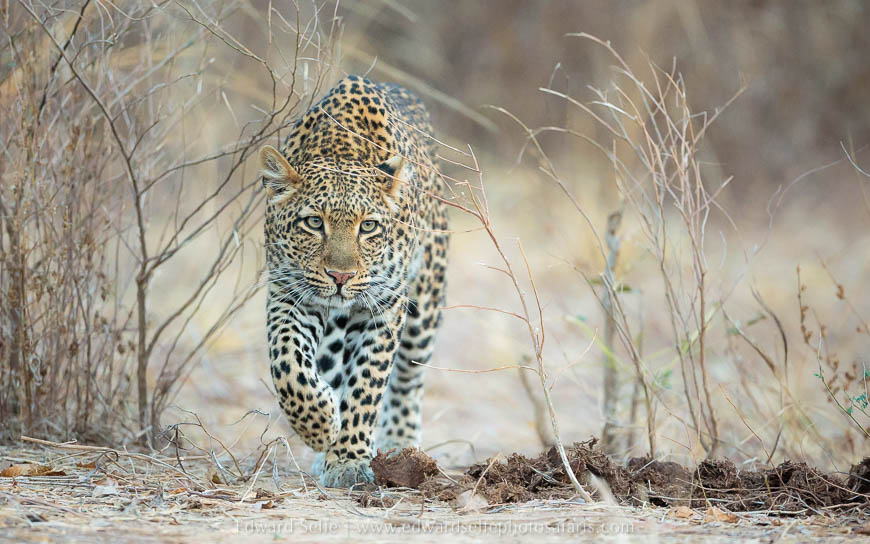
Nsefu Camp laid on a superb bush dinner for us that evening. Due to the cloudy skies during the day, some of the dust had been removed from the atmosphere and the view of the stars that night was truly wonderful. Everyone was buzzing after our Olimba sighting and the feeling of “promise” emerged once more. I knew that we would have a great few days at Nsefu, though I wondered what might top the first afternoon’s viewing.
My plans to return to the area and track down Olimba the following morning were interrupted by the sound of a leopard calling very close to camp during breakfast on the river bank. We finished our coffee and went out in search of the commotion. It didn’t take me long to track down a female leopard who we regularly see in the riverine forest close to Nsefu Camp. We followed her for a short distance but the baboons were also barking elsewhere. I checked around and we found that she was following a male leopard! A mating pair! The male was shy, but we managed to get a great view of him in the distance. As the female followed to catch up, we lined the two of them up and snapped two in the same frame. Little did we know that this was not the only time we would have 2 leopards in one frame.
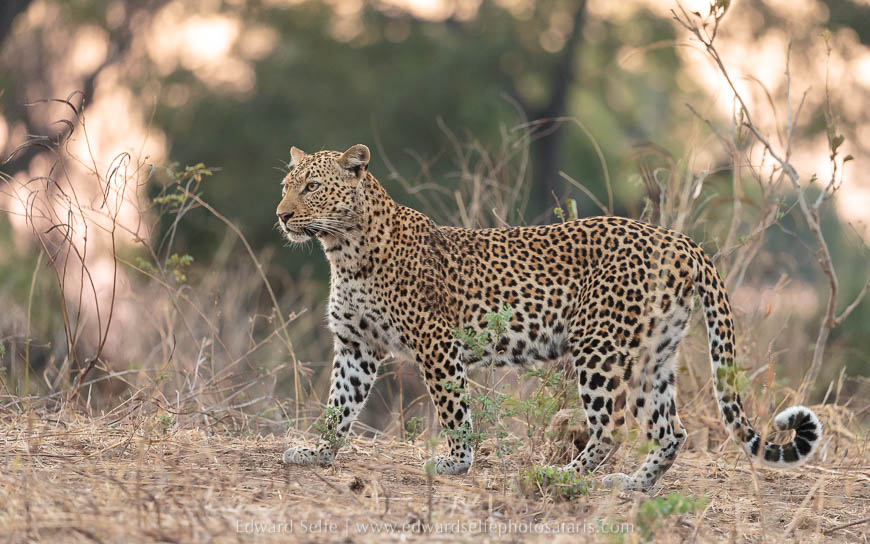
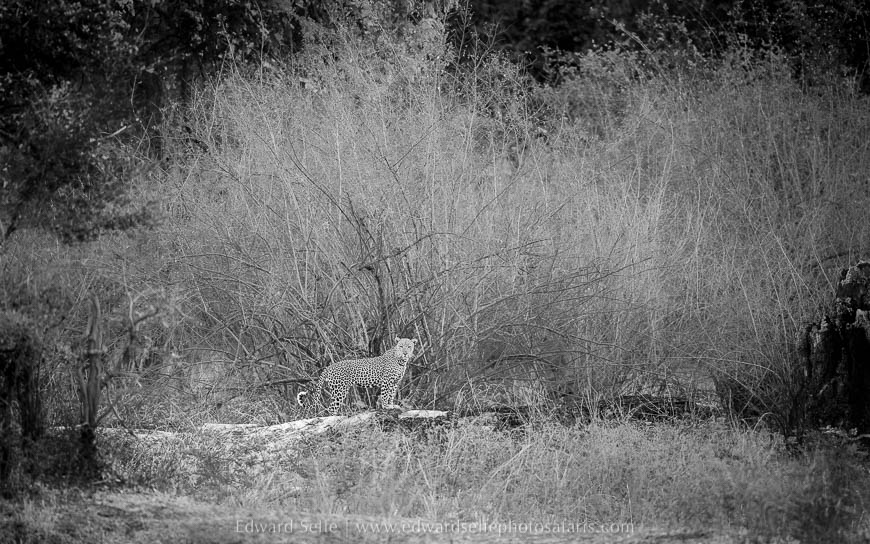
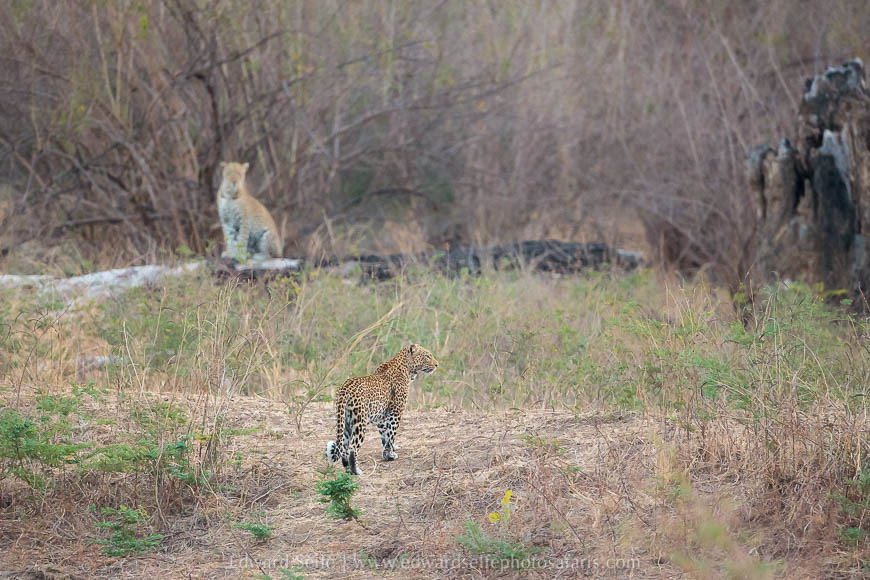
We had used much of the best time that morning tracking the mating pair, so we decided not to search for Olimba at that stage, but to move to the river and check out the sounds of two hippos battling in the water. I think we missed the best of the action, but we saw some displaying and splashing before one of the hippos emerged from the water and moved off. Space in the river is at a premium at this time of the year and hippos often compete for the remaining deep water.
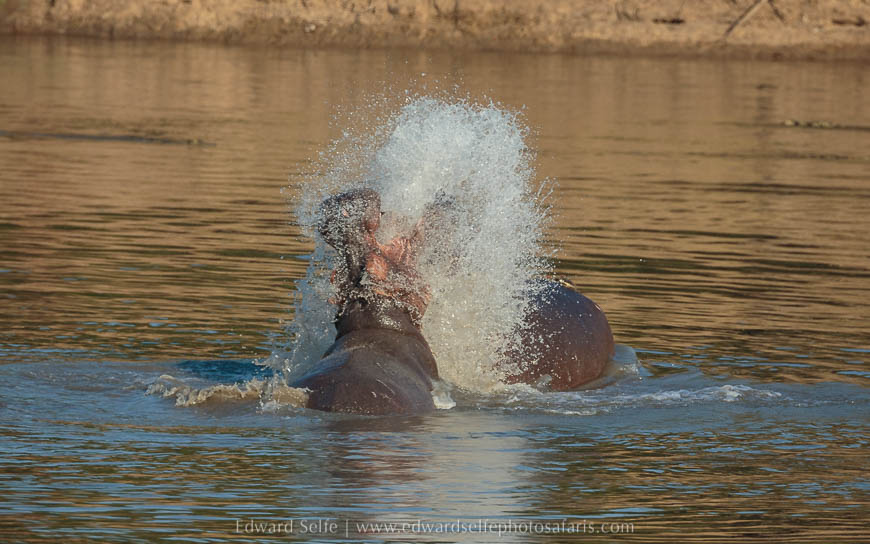
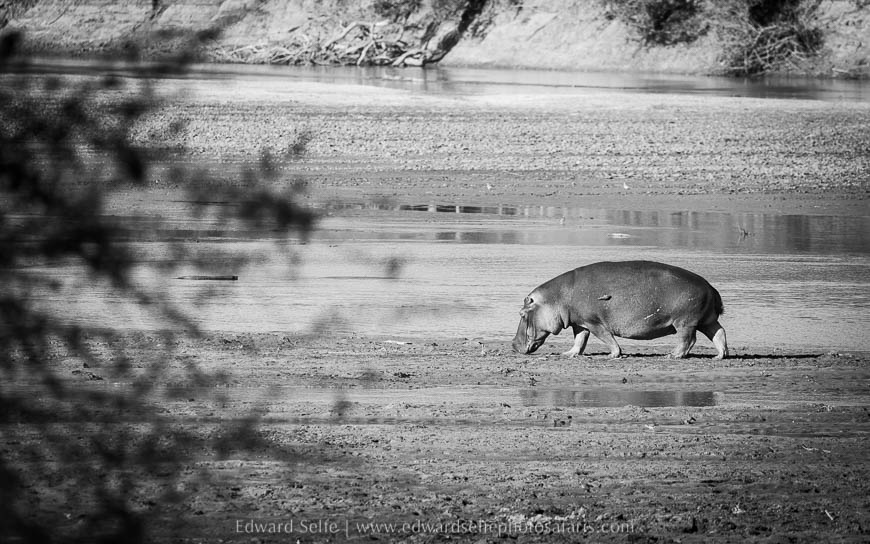
However, we did catch up with Olimba once more, much later in the morning. She was resting in a sausage tree when a puku moved under the tree to feed on the flowers. Strangely the leopard made no attempt to catch the puku, but she never took her eyes off him. When he moved away, she quickly descended and moved off; Olimba defies many beliefs about leopards by hunting in the daytime and moving large distances that are well beyond what many would consider to be a territory.
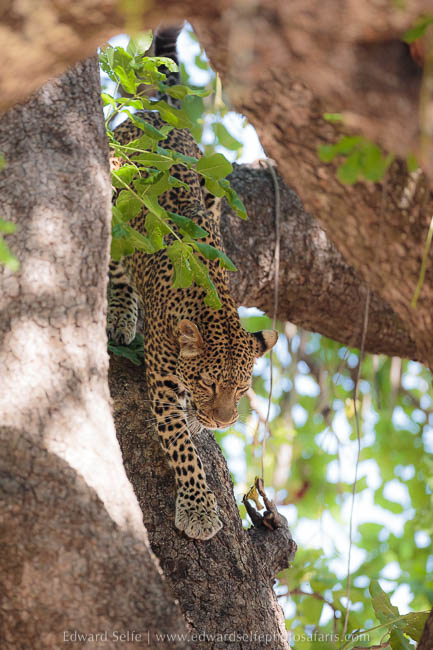
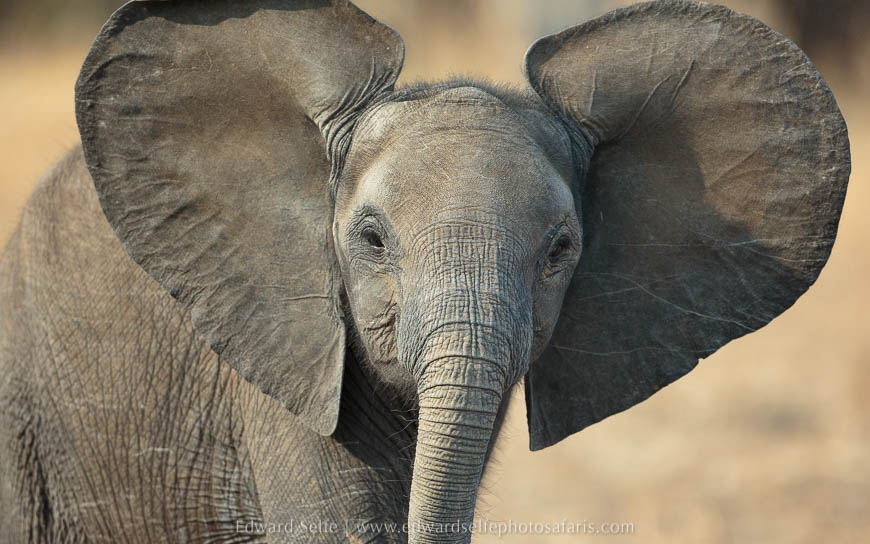
Staring early again the following morning, I took us to the crocodile river where I know the Nsefu pride like to rest during the day. The pride are often spread out, so I wasn’t surprised to find only two females and the oldest of the 6 cubs drinking water in the channel.
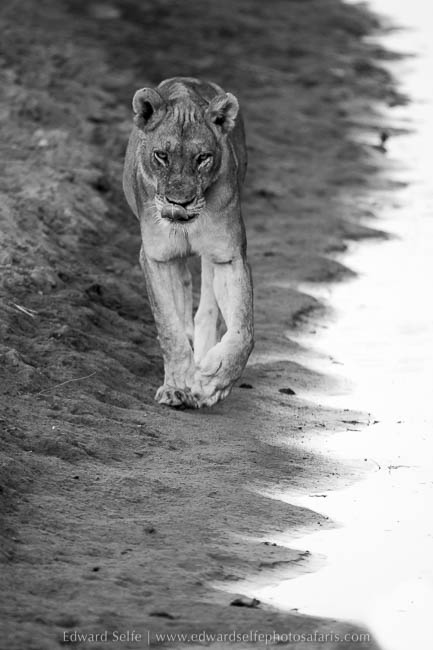
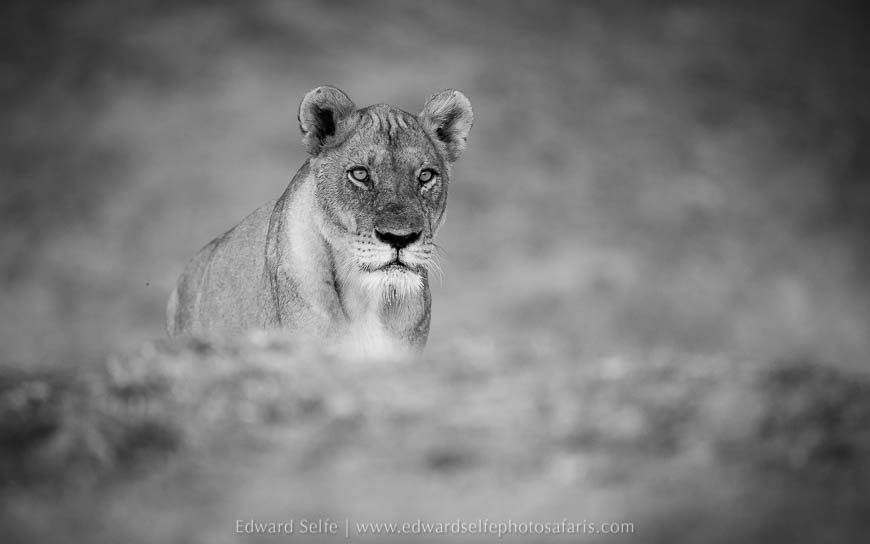
They appeared to be heading to the river, and my thoughts were confirmed when I heard the males call loudly several times from the direction that they were heading. We drove quickly around and found an amazing scene. The males were feeding on a freshly-killed buffalo calf, and the cubs were all crowded around waiting for their turn. Male lions dominate on carcasses, the “lion’s share” being the fee they take for protecting the area and keeping the females and cubs safe from intruding males. As the cubs inched closer, the males continued feeding and then swiped at the youngsters with no warning at all! They were up against a small bluff meaning that the only available angle was shooting in to the light, but we all got some good shots and we enjoyed the amazing interaction.
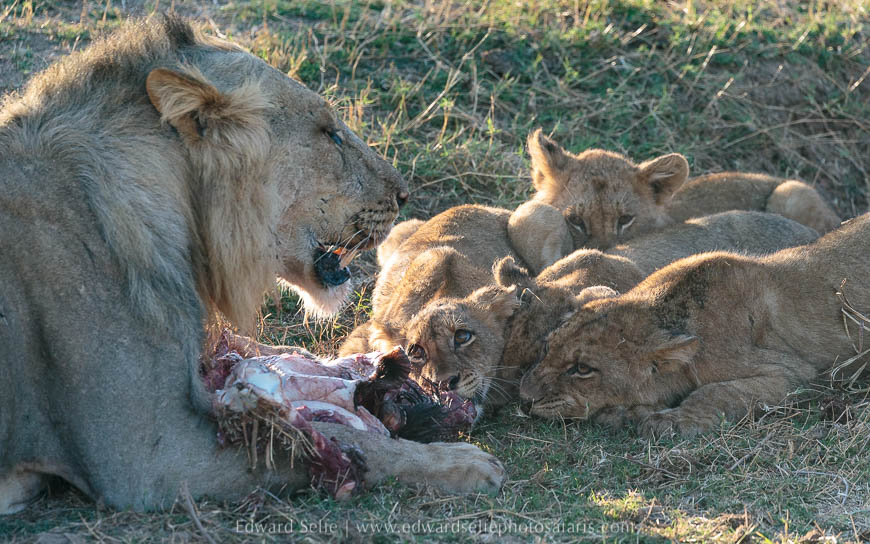
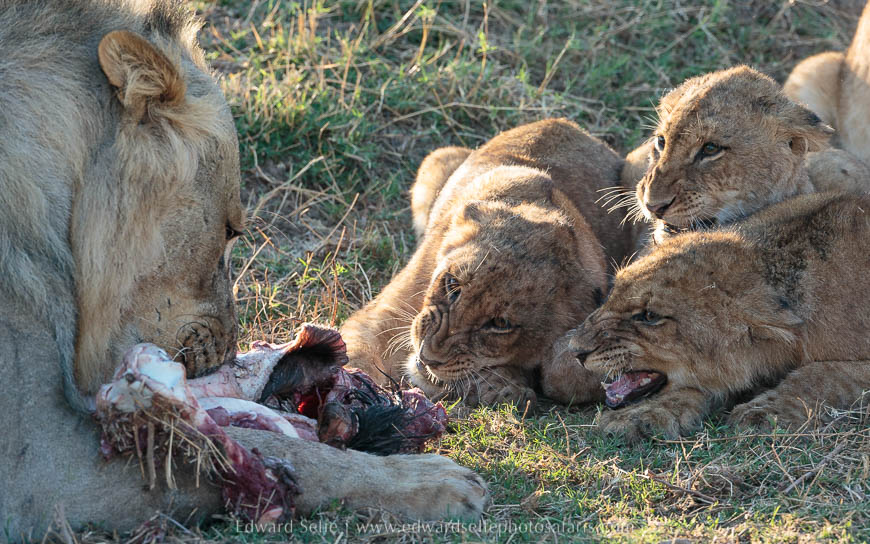
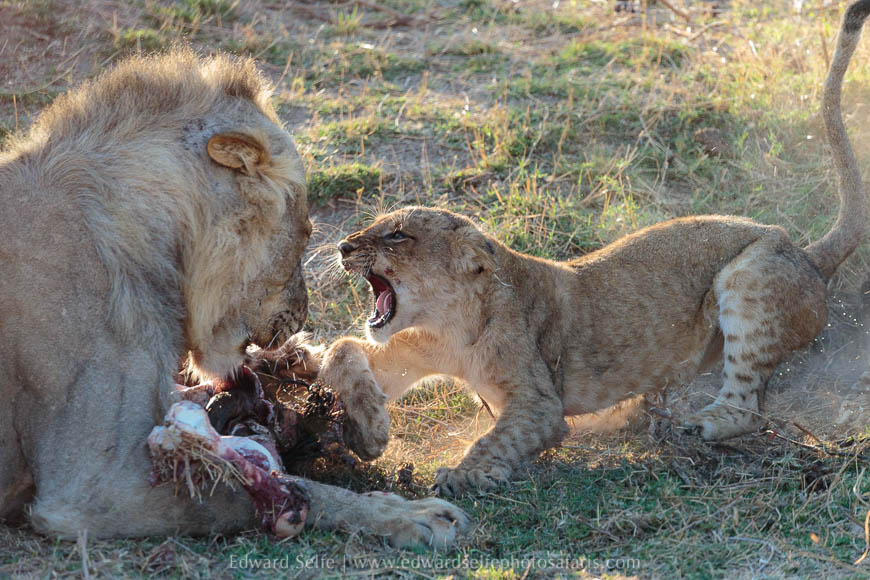
The two females and older cub never appeared, and I began to wonder what had delayed them. As I moved off to look for them, I saw a couple of the other females running into the thickets with the cubs in tow. Nothing will entice a lion to run during the day except the chance of food, so I suspected that the 2 females had killed something and the other lionesses had heard it. Whatever was going on, I wanted to be there. As I got closer I turned off the engine to listen and I heard the unmistakable sound of buffalos bellowing. Turning the final bend, we found the lionesses and a young male piling on the back of a buffalo cow. A nearby buffalo bull was trying to chase the lions off, but their adrenaline was up, and nothing would stop them.
The bush was think in that area, so I tried to move the vehicle to get a good view. In the meantime, the buffalo ran into a gully and out of sight. Amazingly, she emerged up the other bank, and appeared back at our level, whereupon the lions brought her down in seconds. It was brutal but mercifully quick. From initial impact to death can have been no more than 4 minutes; extremely quick for a buffalo kill.
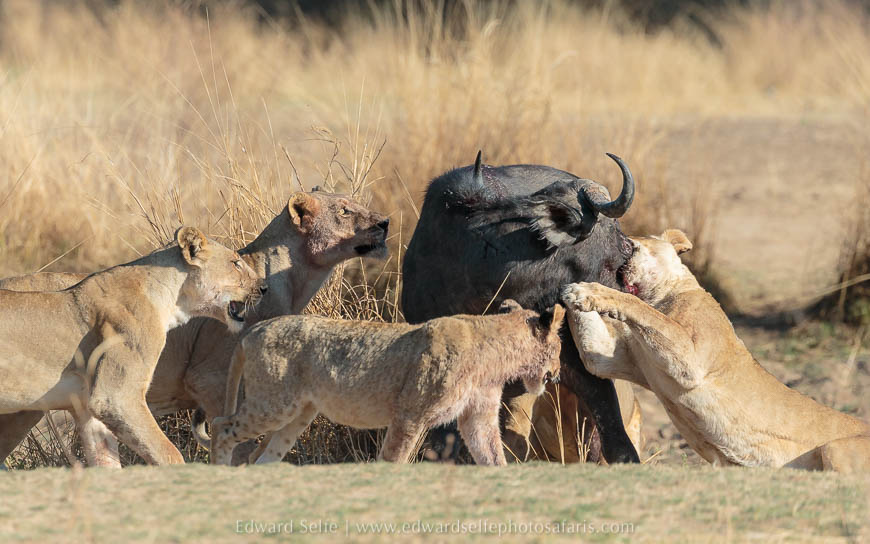
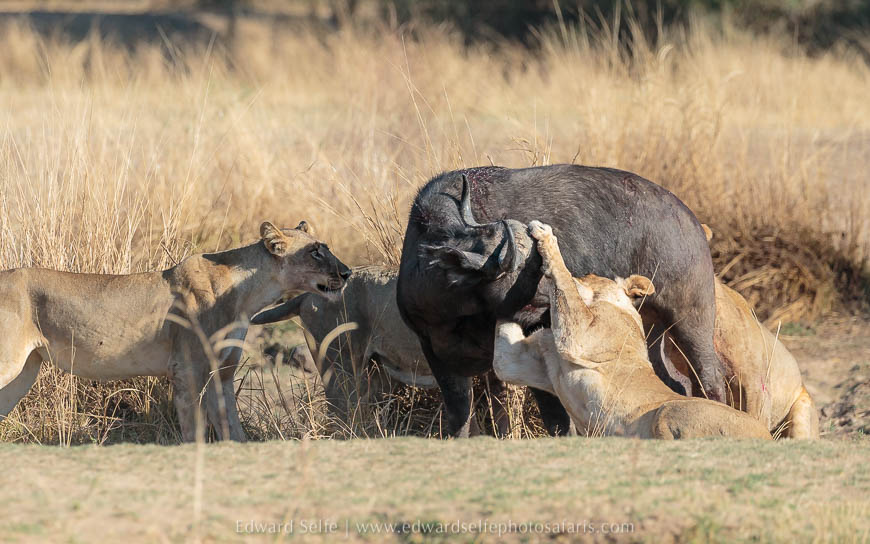
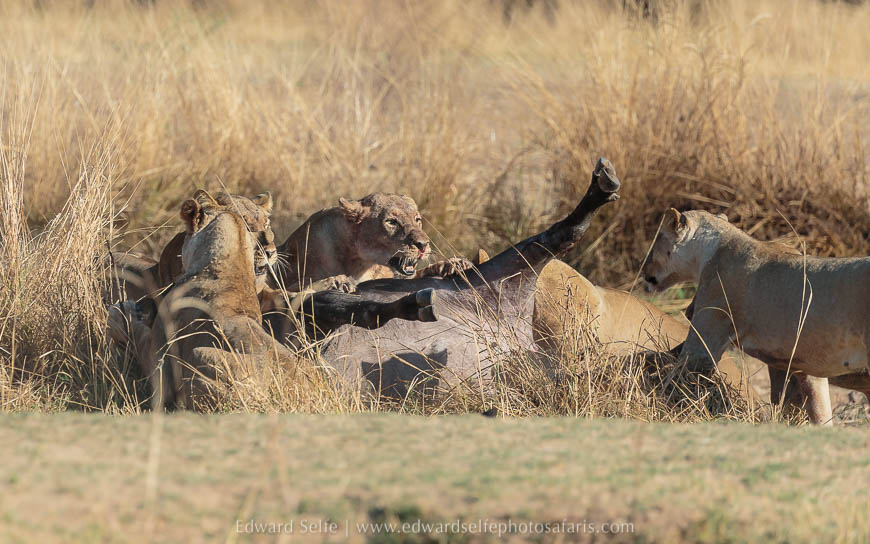
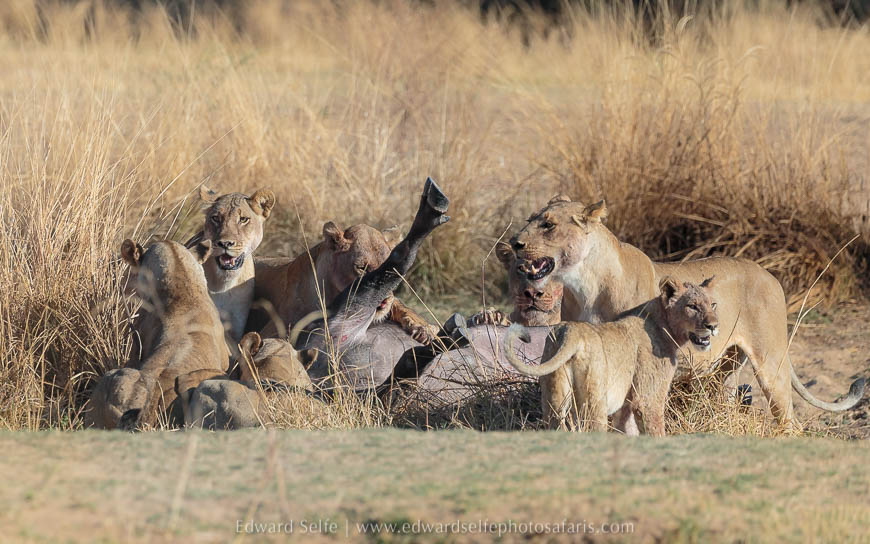
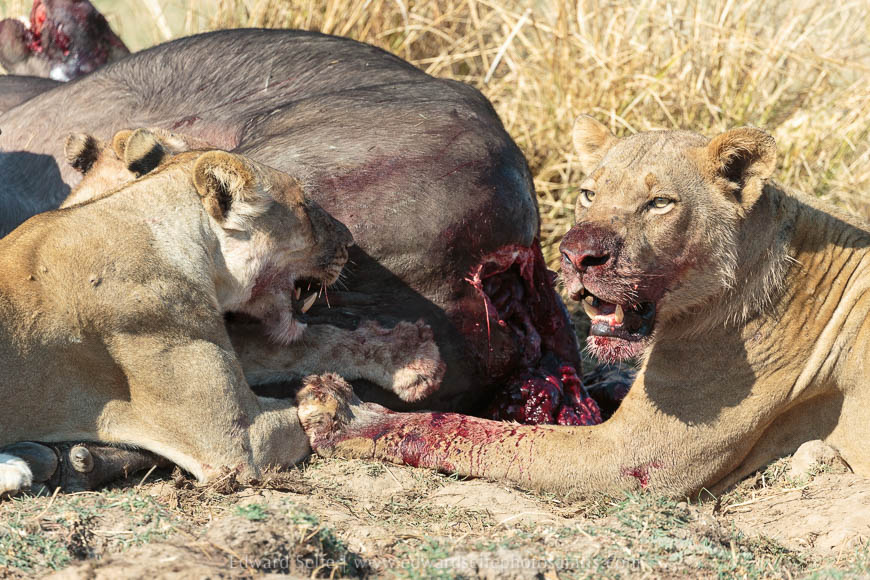
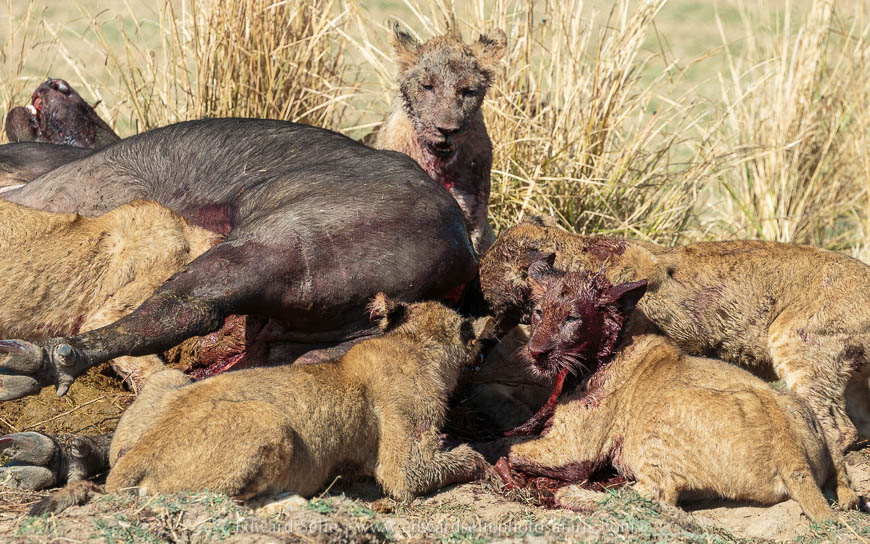
The lionesses caught their breaths and looked around nervously expecting the males to rush in and dominate the kill. Fortunately, the males were full from the first buffalo kill of the day, and showed almost no interest in the new carcass. After the situation had calmed down and no other lions or scavengers had appeared, the lionesses called the cubs and they joined the feast.
It is quite rare to see a lion kill in full daylight, and even more so to see it out in the open. I had been expecting a long battle, but the buffalo was a cow rather than a bull, and much weakened by the nutritional compression of the dry season’s peak. Watching how the lions worked together to fell a large, dangerous creature was incredible, and I am grateful that the process was as brief as could be hoped for. No one likes to see an animal suffer, but lions can be inadvertently cruel in their attempts to kill without getting injured themselves. It seems the Nsefu pride were highly professional on this occasion.
Exhilarated, exhausted and with over 1000 images to sort through, we headed back to camp…..via a wonderful bush breakfast surprise! The initial location had been set for the exact spot where the lions had killed the buffalo so I had radioed a message to camp that we needed a new location! They obliged and we enjoyed cooked breakfast along a stunning lagoon just south of camp. What a way to end the morning!
Our plan for the afternoon was to explore new areas, knowing that the lions would be highly inactive in the heat. We spent time with elephants, did some landscapes and enjoyed a stunning sunset! We passed the lion kill in the dark and found an unwanted visitor at the table…. No one was paying him much attention so long as he didn’t try to take his share!
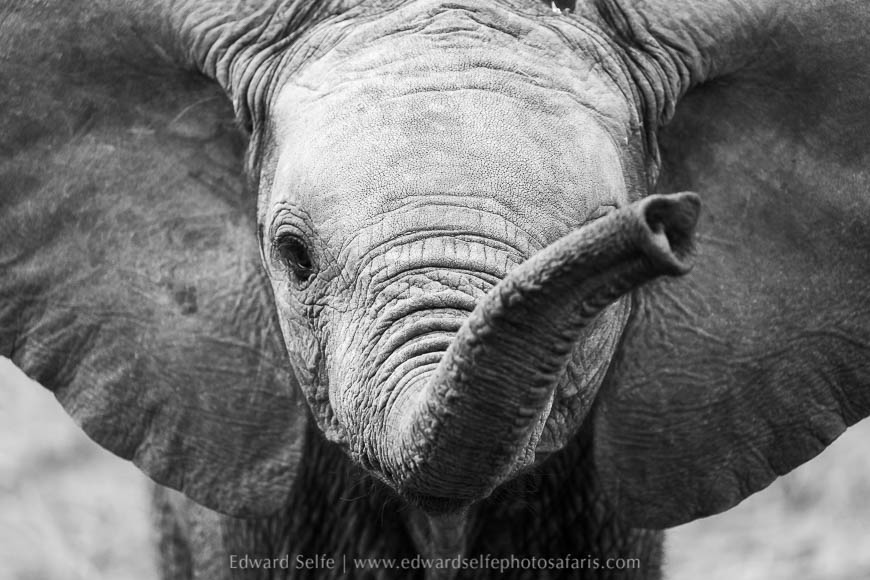
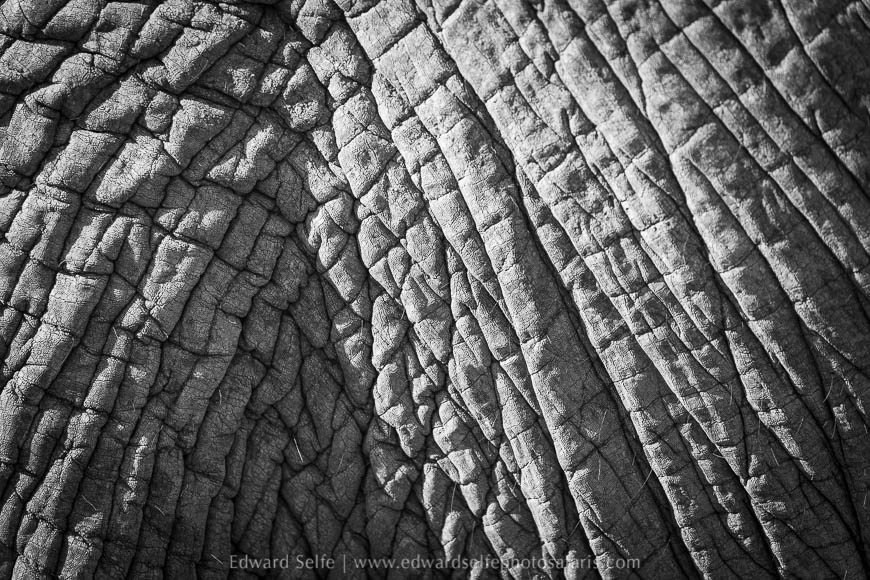
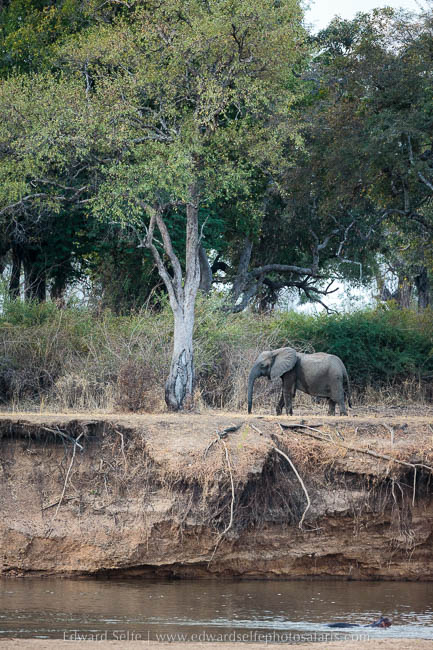
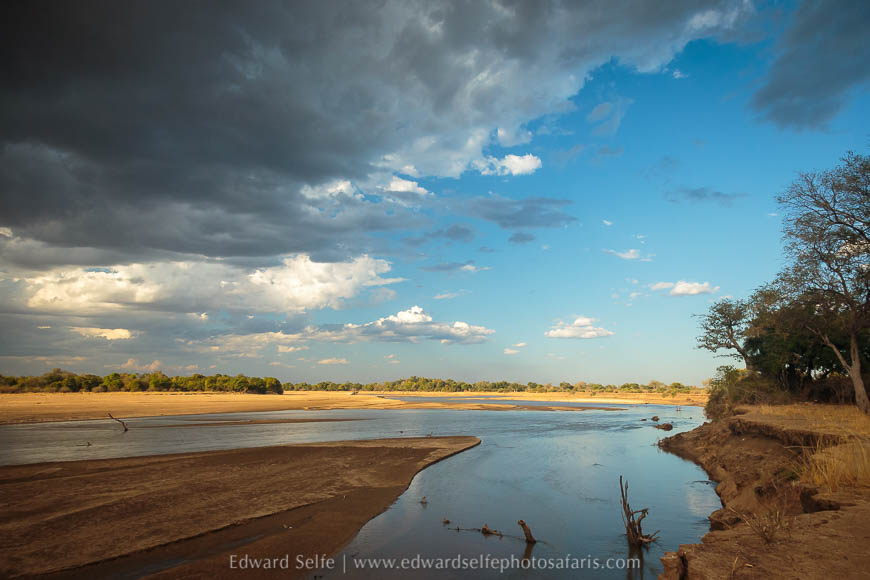
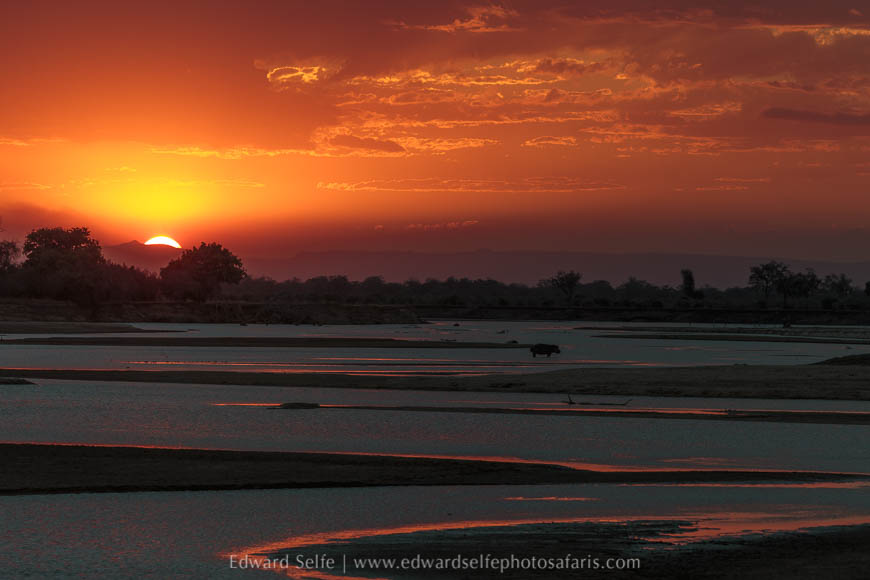
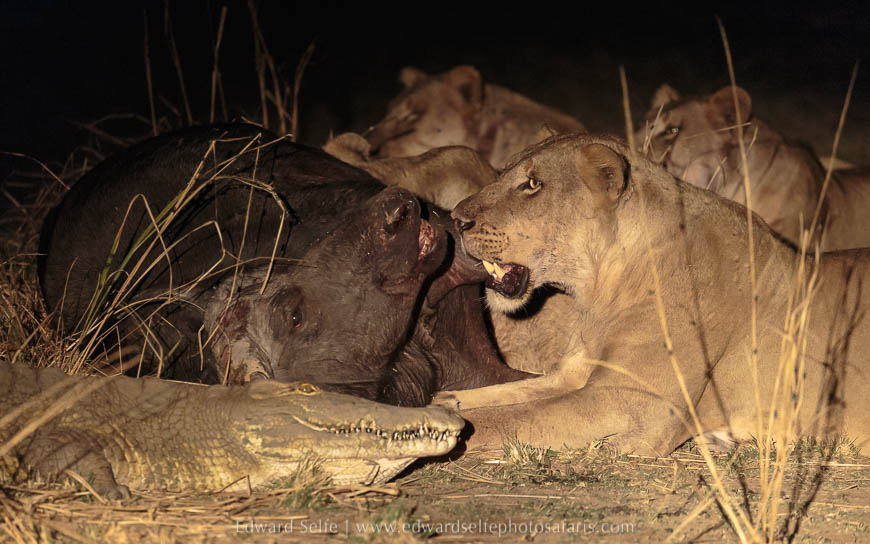
Our final full day was spent entirely in the company of Olimba. We found her early in the morning with a freshly killed impala under a bush.
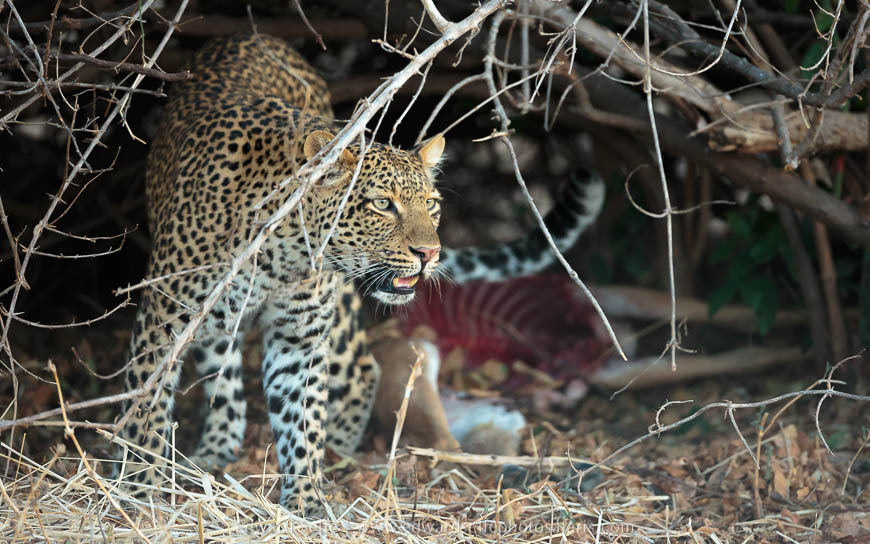
We hoped that she might drag it out of the bush and take it into a tree, or at least call the cub to come and share the meal. So we waited. It didn’t take long before the sun started to hit the bush she was hiding in, and she decided she needed to take the carcass elsewhere….but into another bush, not into a tree! We were worried that the hyaenas might find it, as they have done many times, so I was dismayed by her decision.
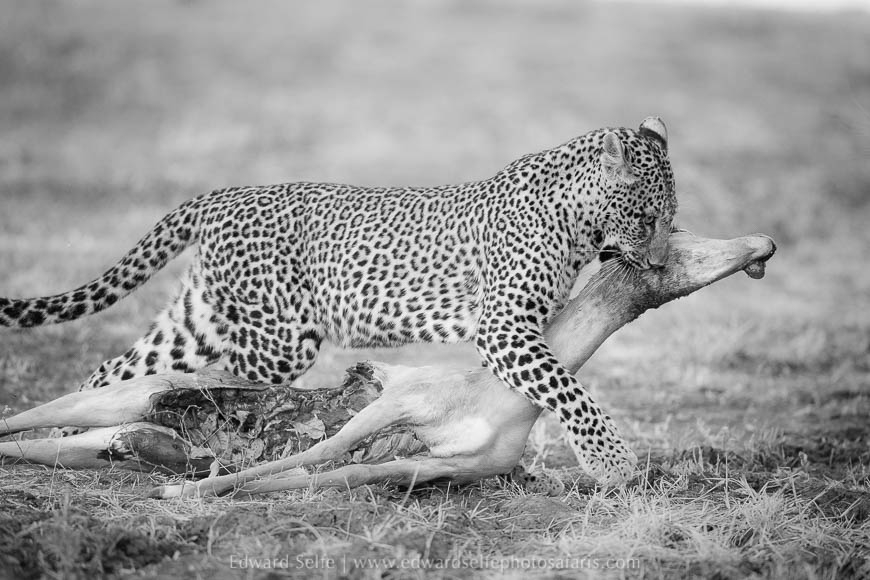
However, she did then call the cub and it was wonderful to watch the little one creep across the open ground and finally rush to join his mother at the edge of the bush. I prepared my guests to ensure they had enough shutter speed for the play that I knew would follow, but even I was amazed at the speed and incredible agility of the youngster. He has really grown in confidence since I last saw him.
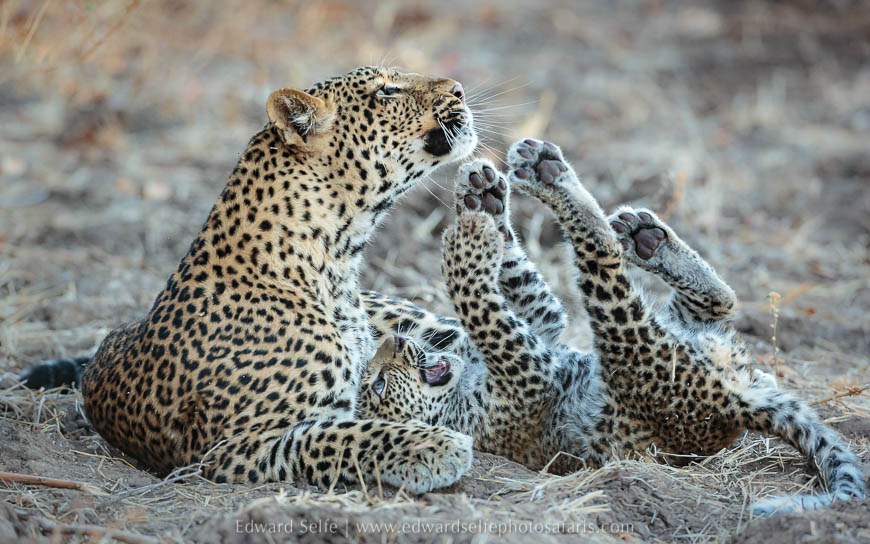
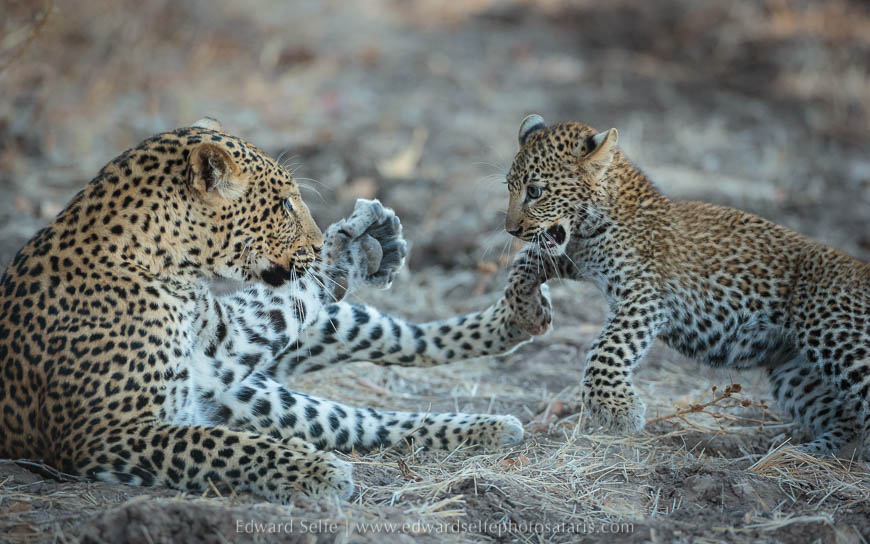
We returned in the afternoon, hoping that the carcass would be in a tree, and the cub did return to his mother but only after the light had fallen. We’d enjoyed such a great time in the morning that we left them in peace and went to have a final sundowner in a beautiful spot. On the way to sundowners, we bumped into another leopard (the Luangwa is full of leopards!) but it was dark and we decided that we had seen enough leopards for one day.
We had time for a short morning safari on our last day, so we headed out with the intention of checking on Olimba who had dragged the carcass into a tree later in the evening (reported by one of the other guides at Nsefu). However, as before, we didn’t get far as I located the mating pair of leopards again as we left camp! Once again, the male gave us only a brief viewing before rushing off, but we spent an hour with the female as she called, marked territory and followed the male. As she arrived at the river, she spooked some puku who stood tall and whistled their displeasure. It was fitting that a long Luangwa safari should start with a lion kill on the first evening and end with an hour’s leopard sighting on the final morning. Entirely satisfied, we returned to camp to pack up and head home.
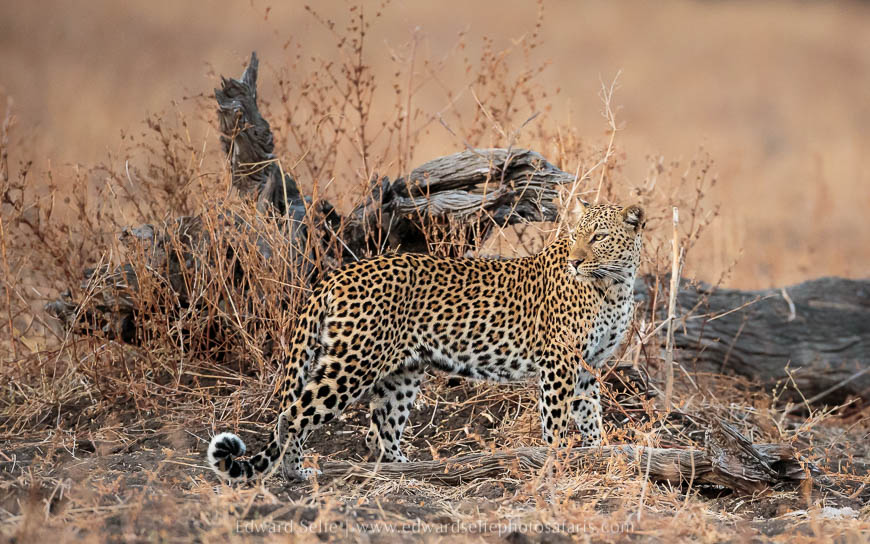
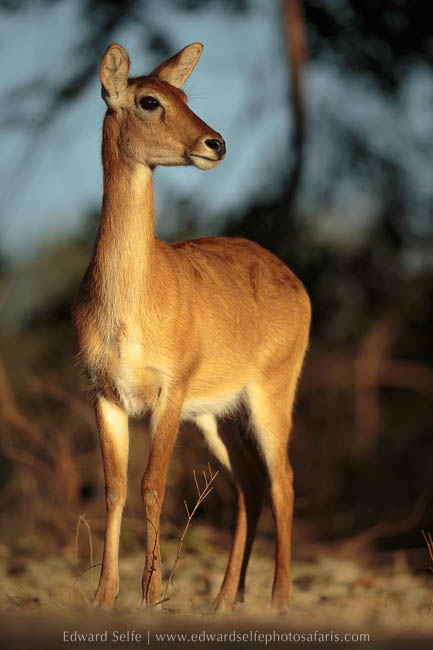
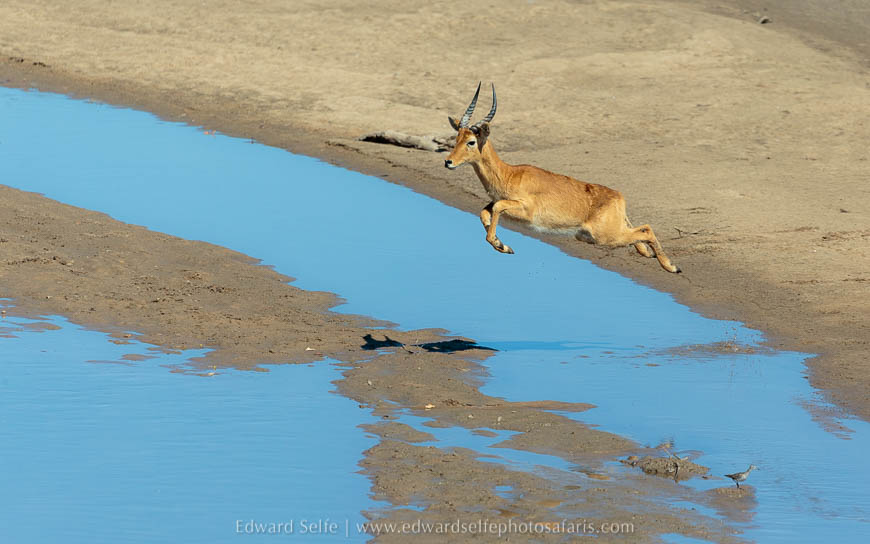
I was thrilled to see the images that my guests created during the safari and particularly to see that the advice I was giving was making sense and helping them get the best from each scenario. I look forward to welcoming John and Kent back in 2019 – yes, they are already making plans for return trips!
It is impossible to report all the events of a 16 night safari. The above records are really just the main highlights, displayed through 80+ images and 8 videos. In between there were stunning sceneries, beautiful birds, interesting interactions and so much to observe and talk about. There is such richness of life in the Luangwa that each and every outing from camp is filled with sights, smells, sounds and memories – there’s really nowhere like it.
If you would like to share a safari in the South Luangwa with me, please do get in touch. Space in 2019 is very limited, but some single and double slots are open, and 2020 is already starting to fill. I would love to show you around this wonderful place. With my thanks for reading right to the end.


